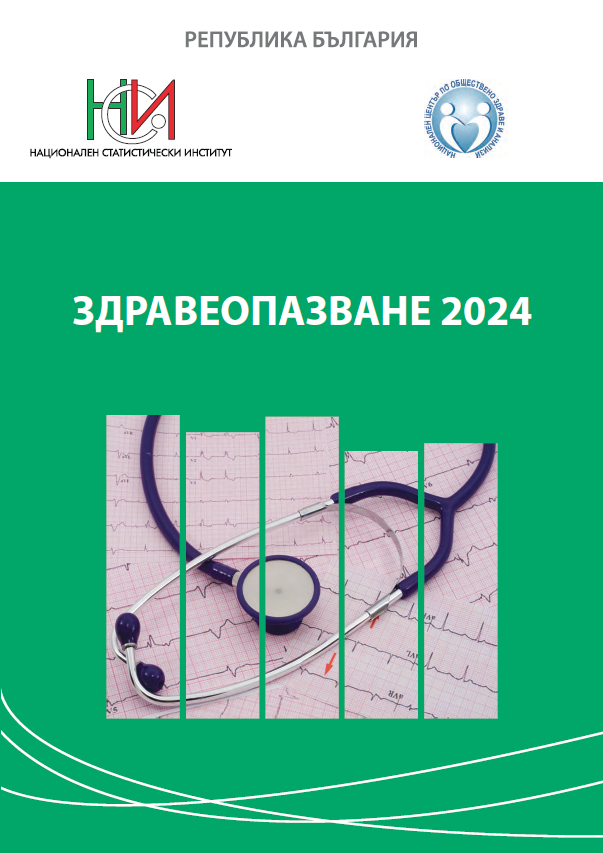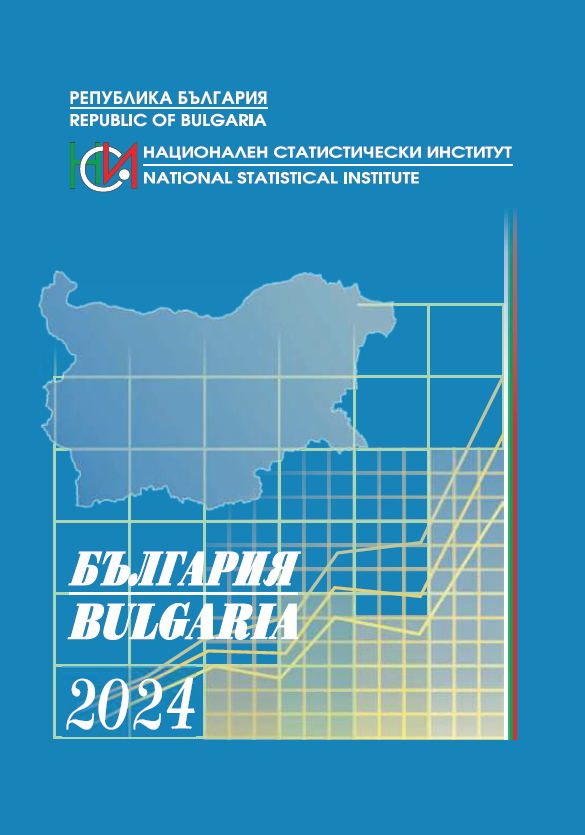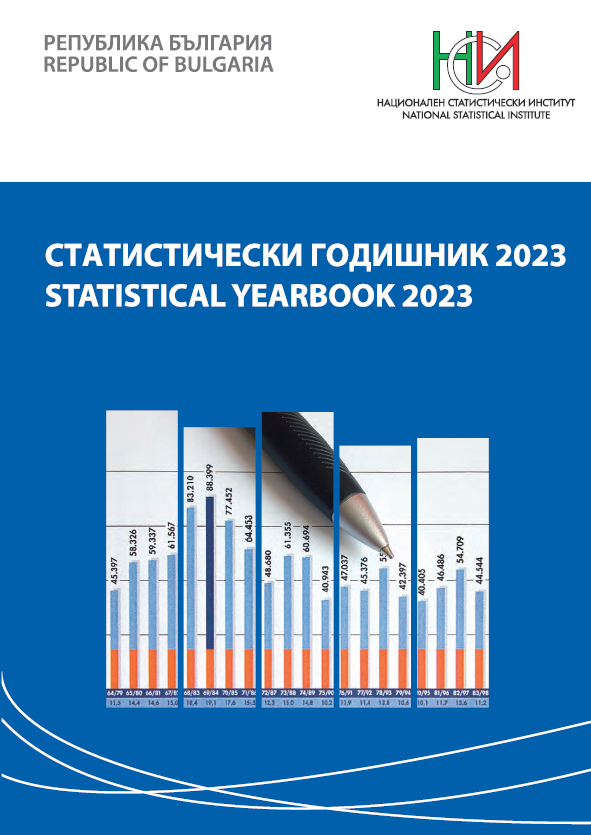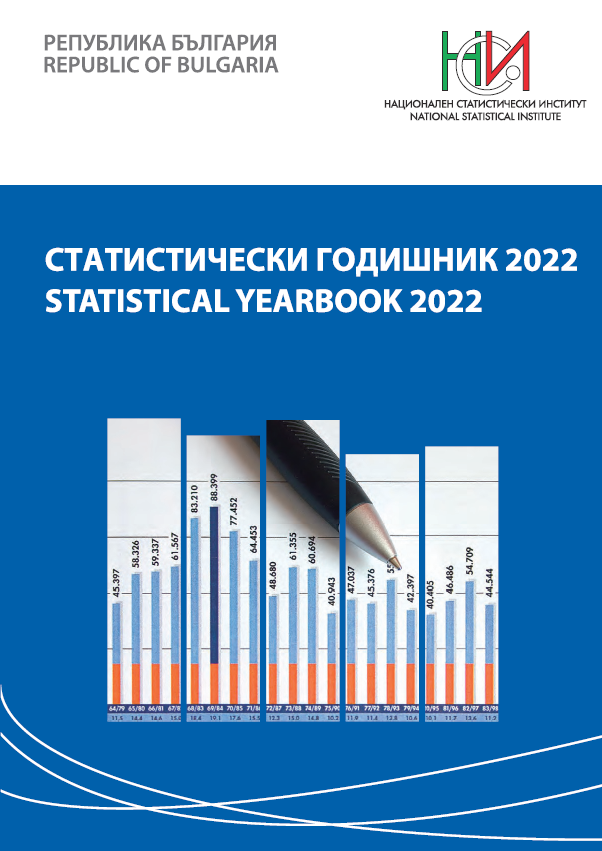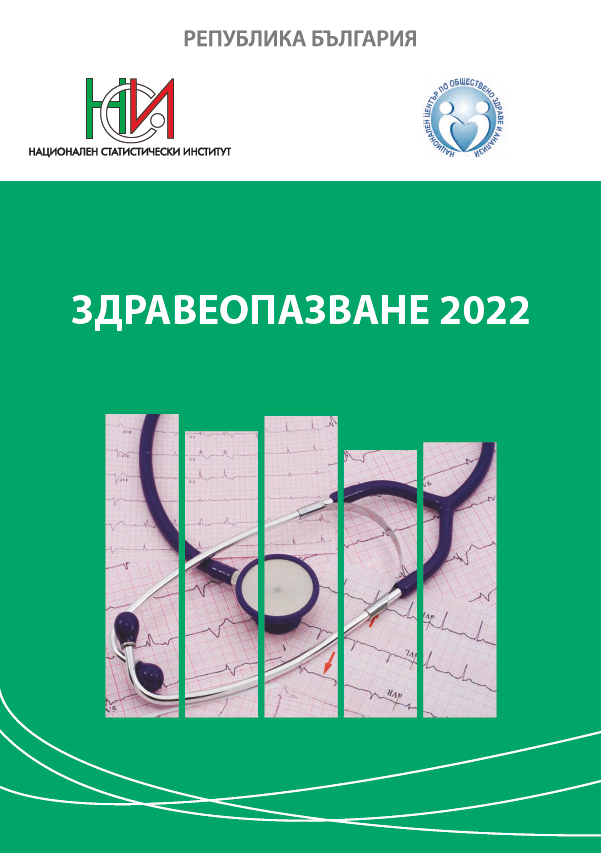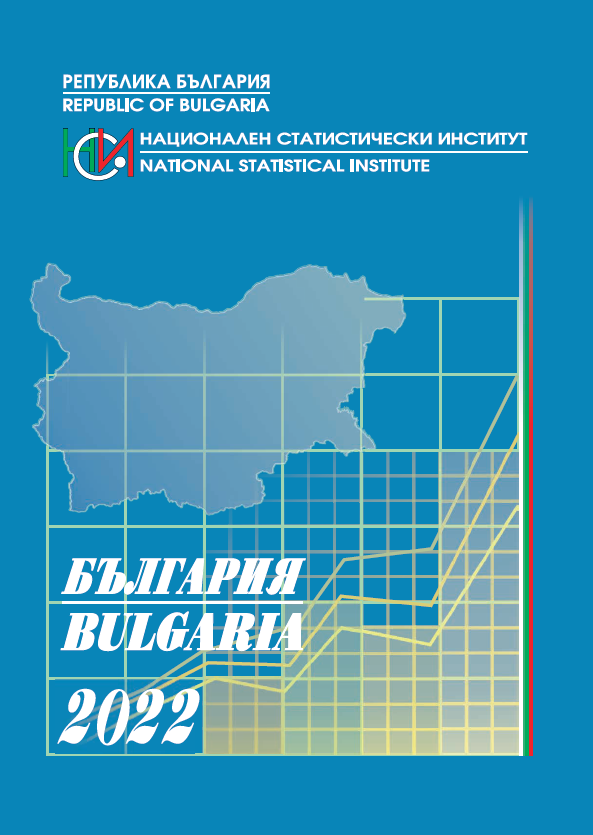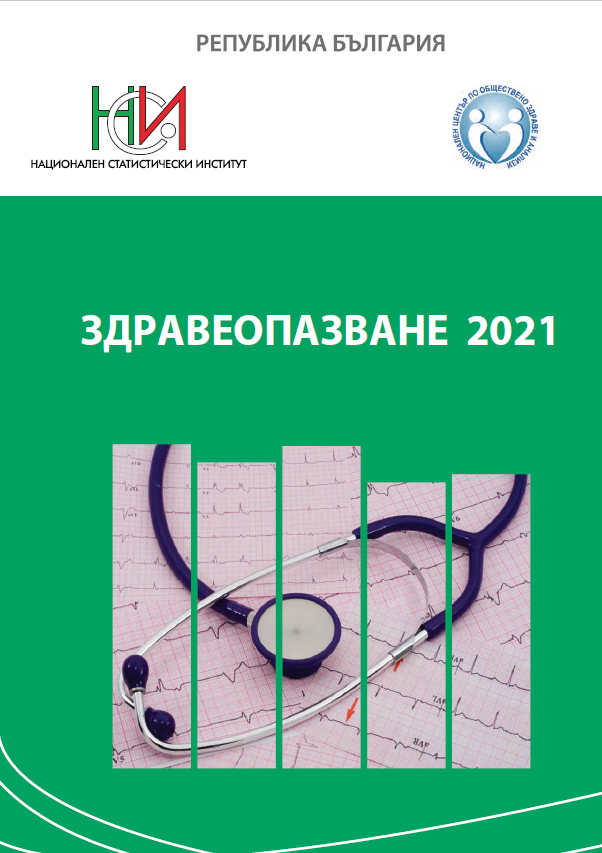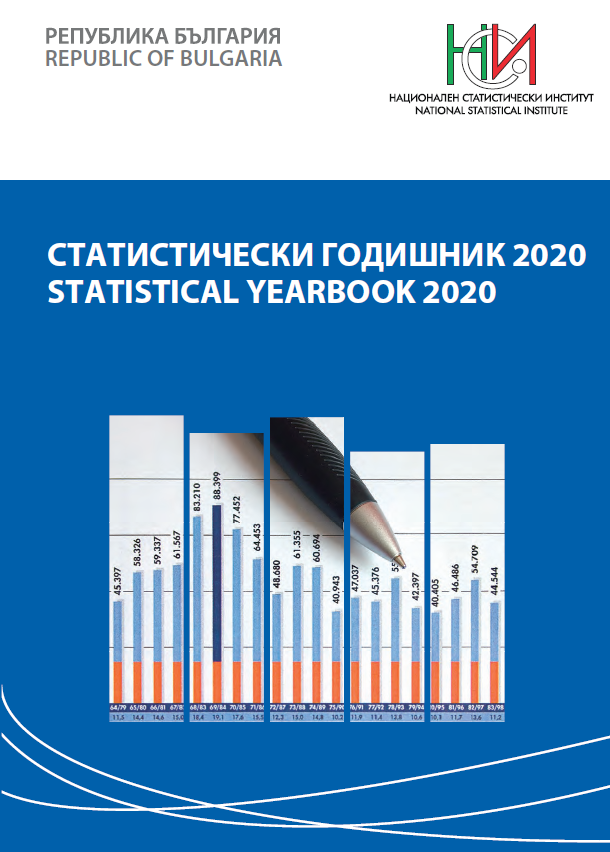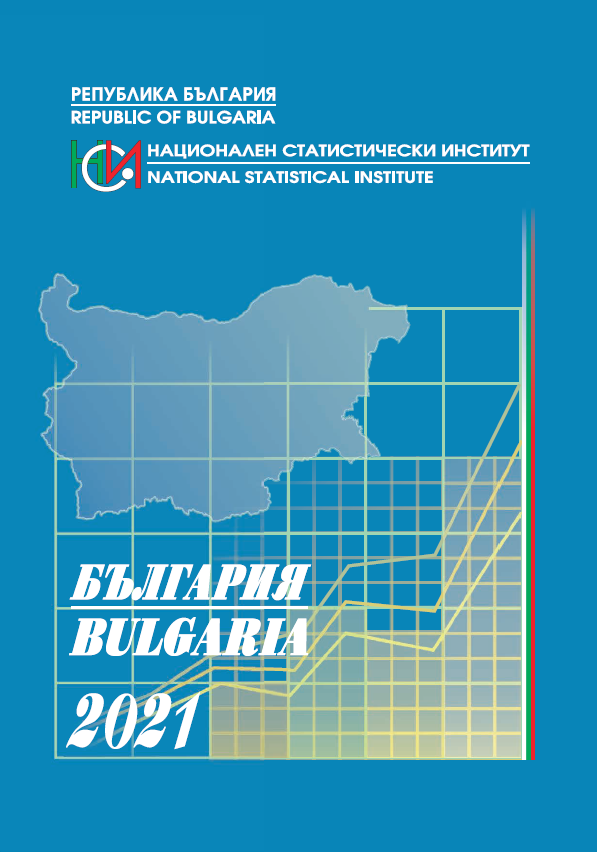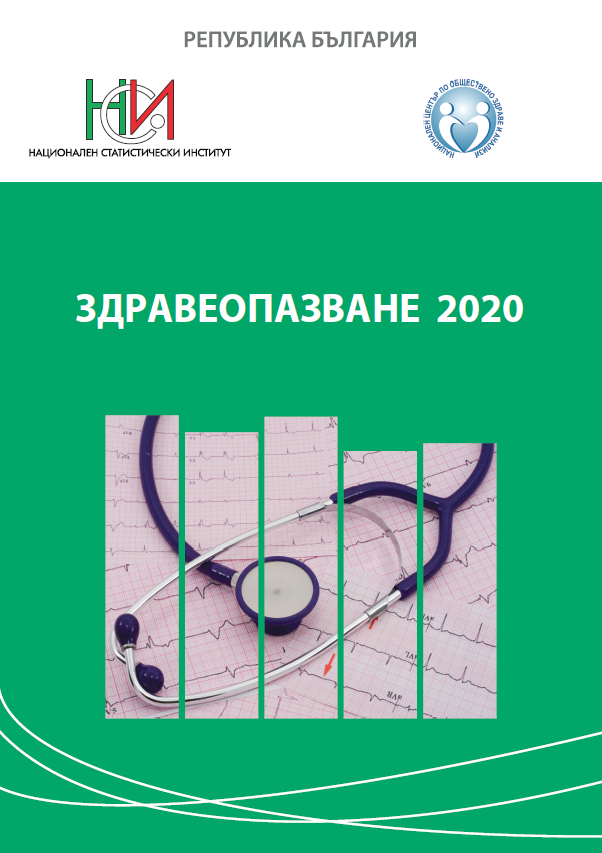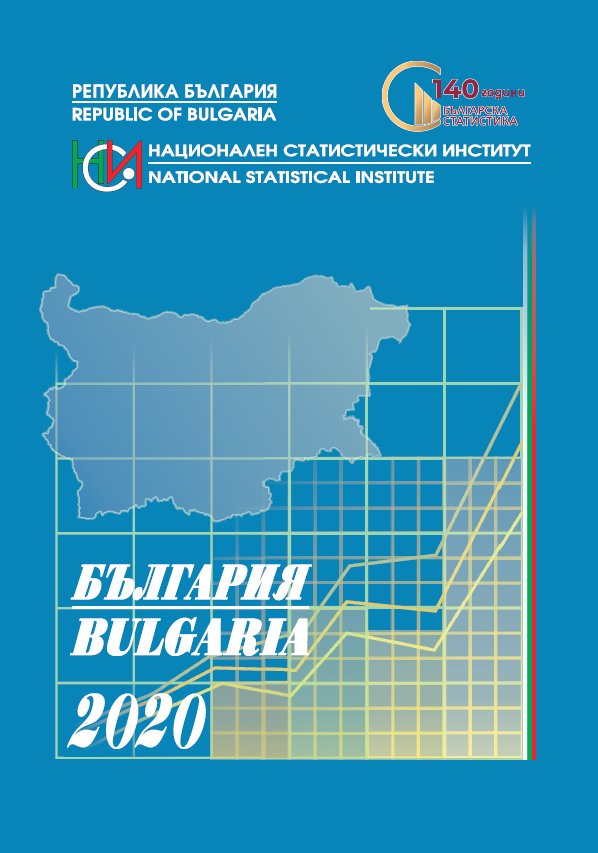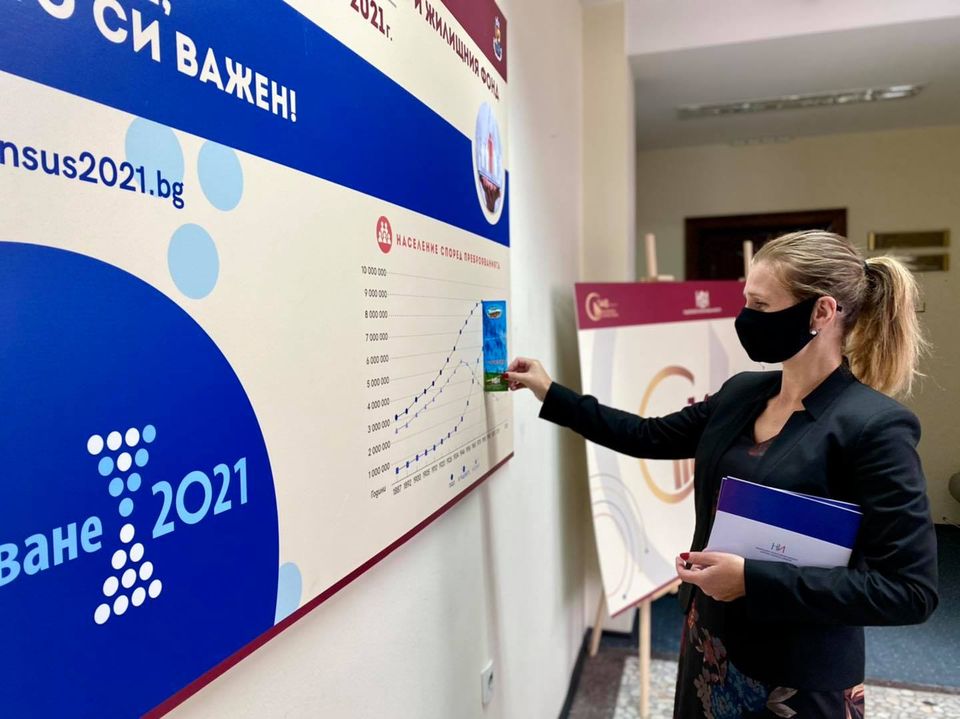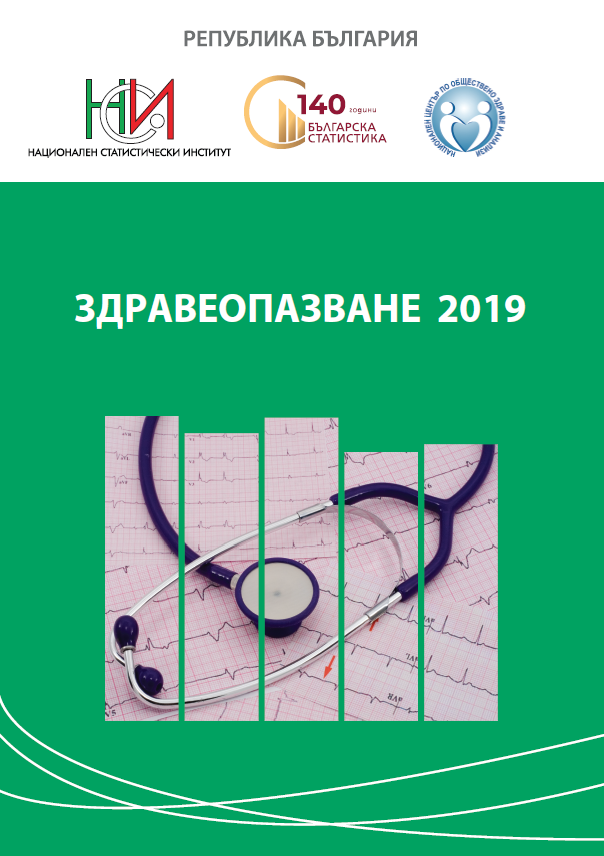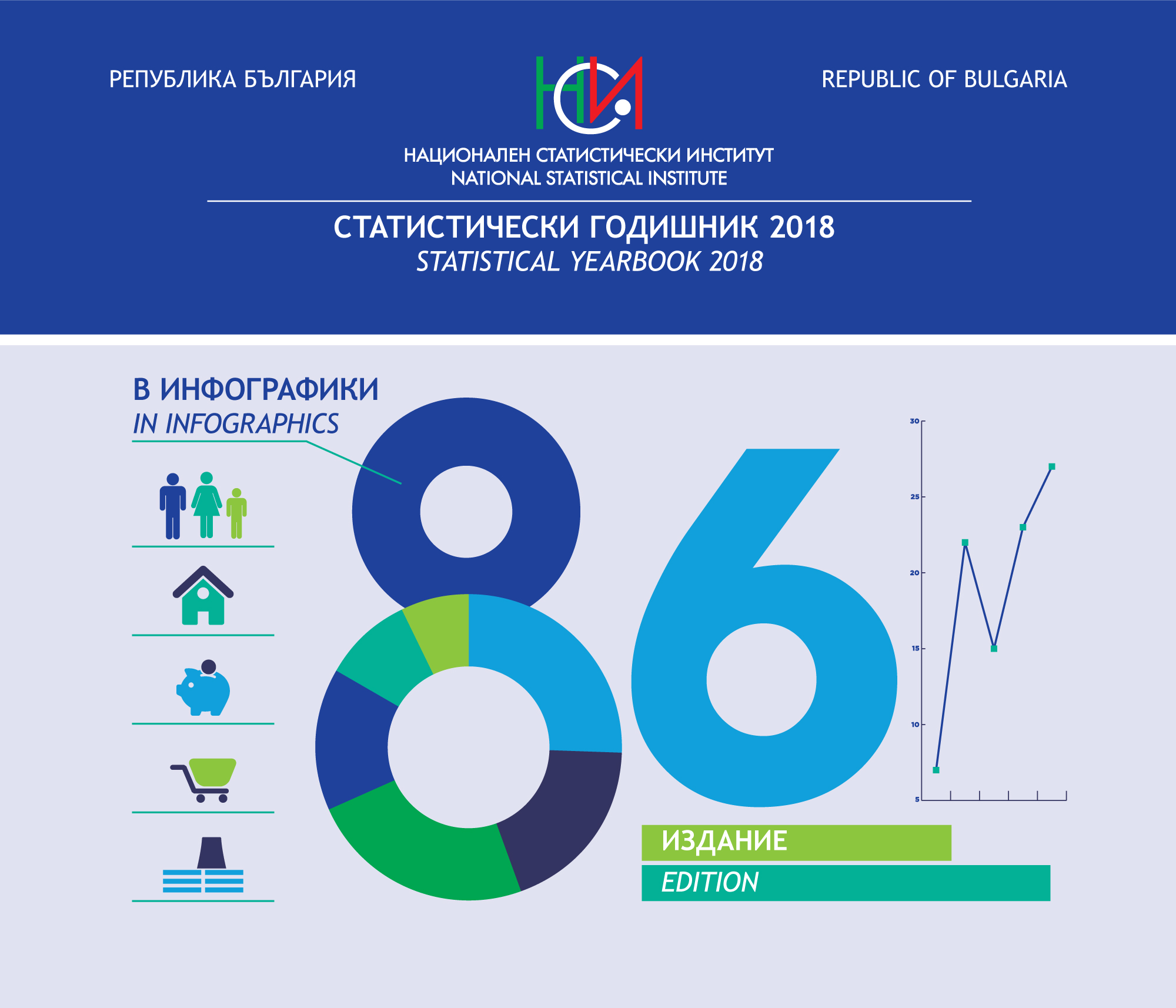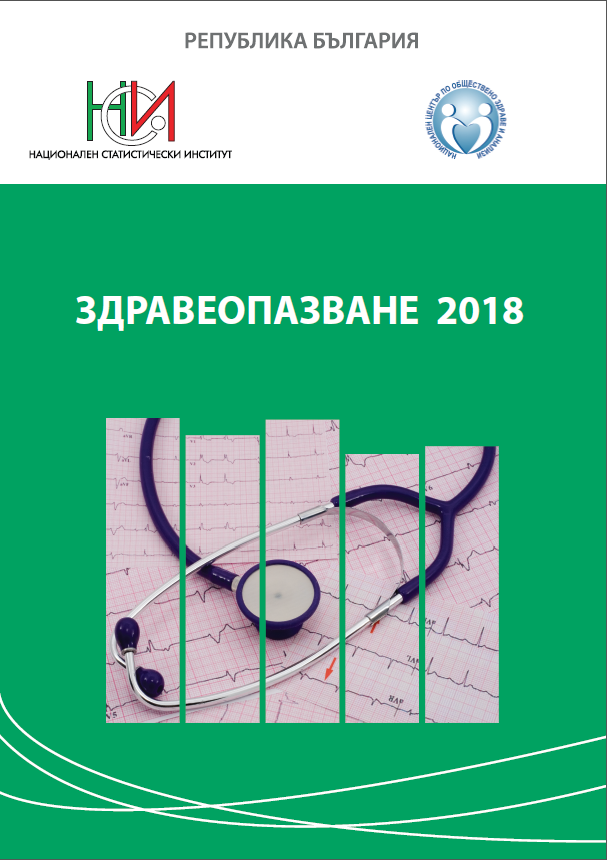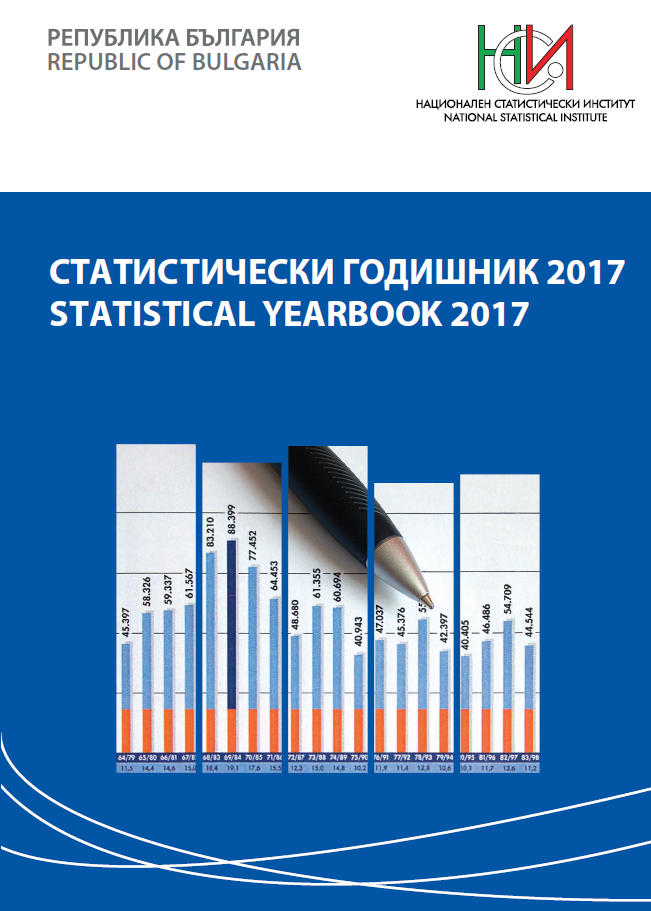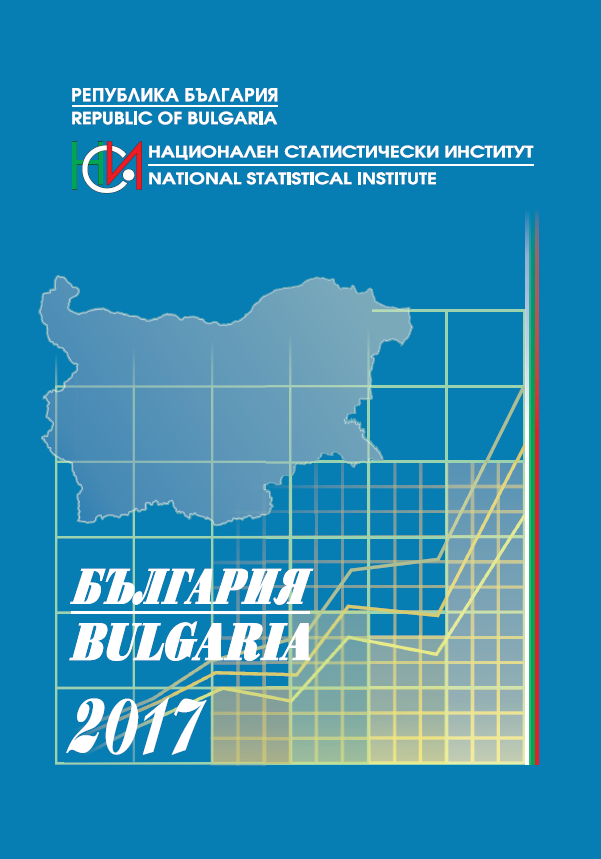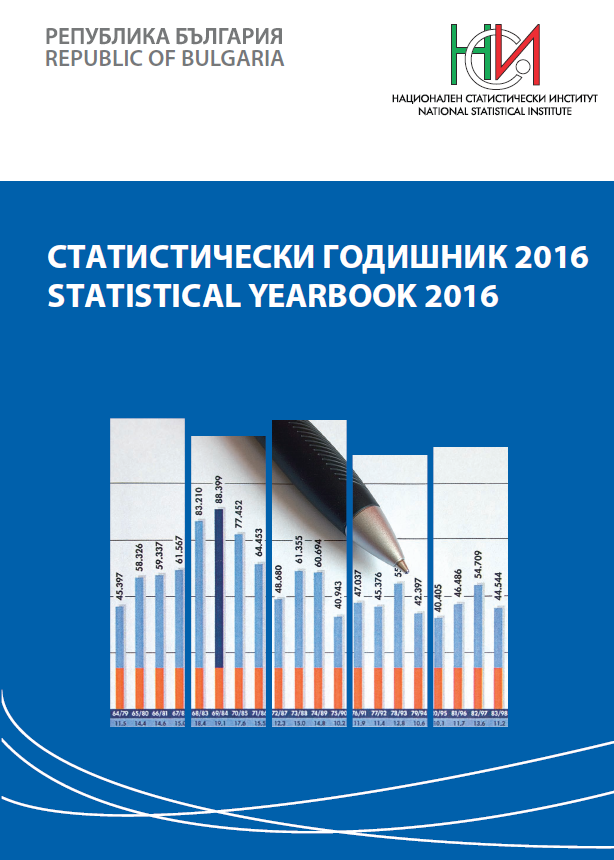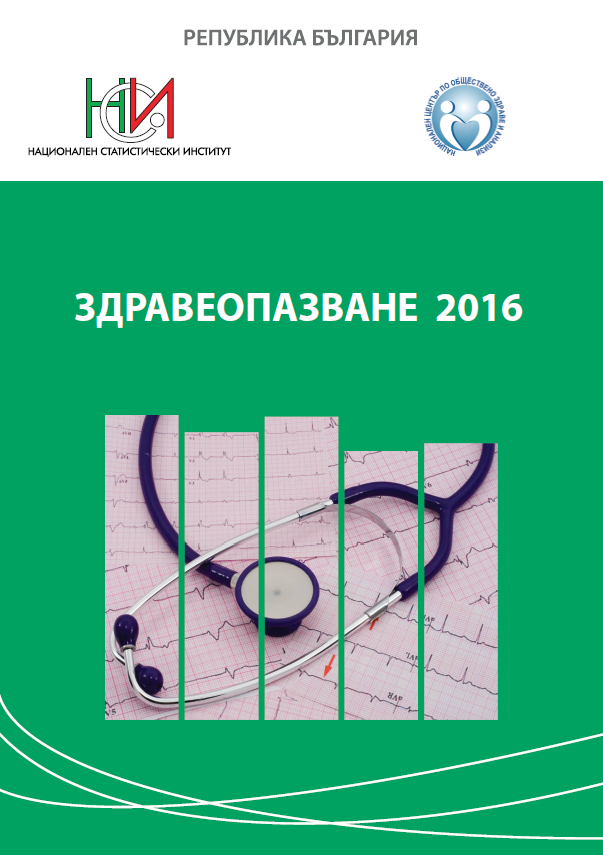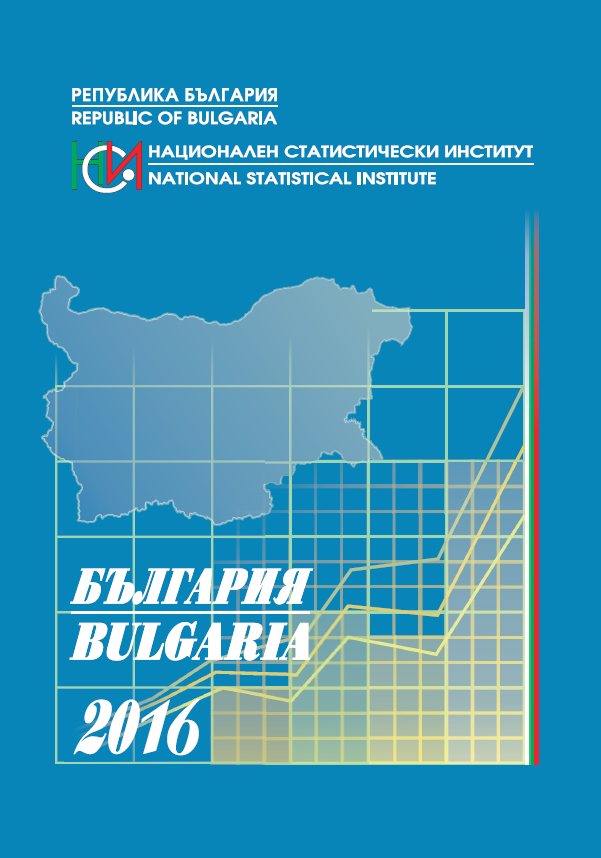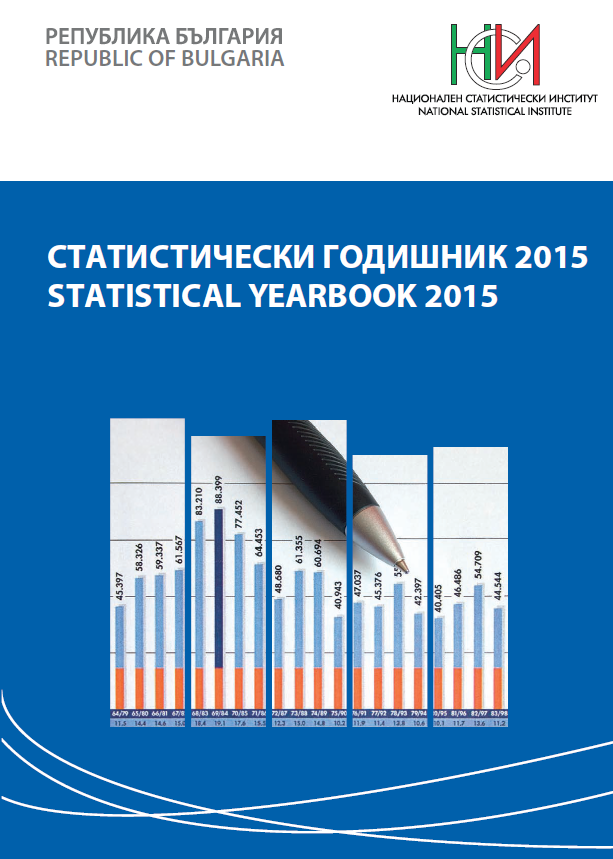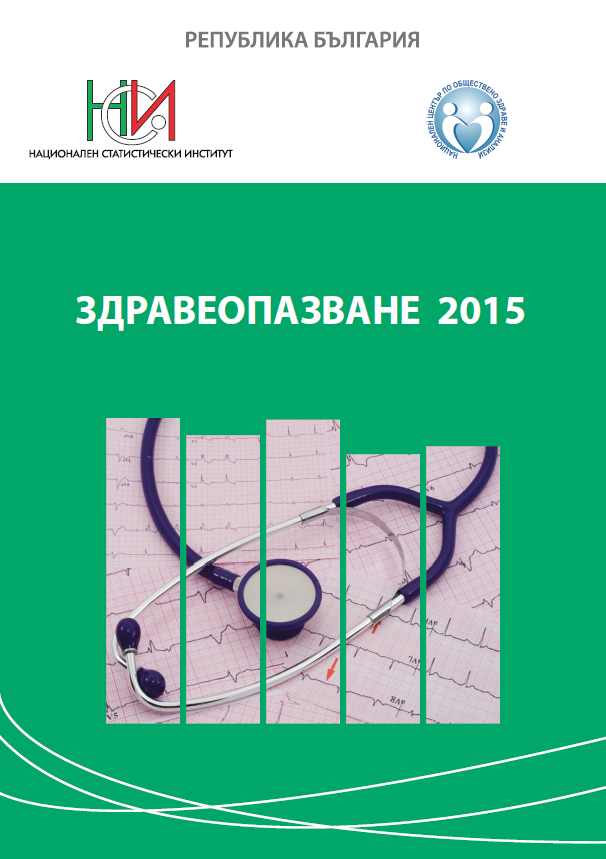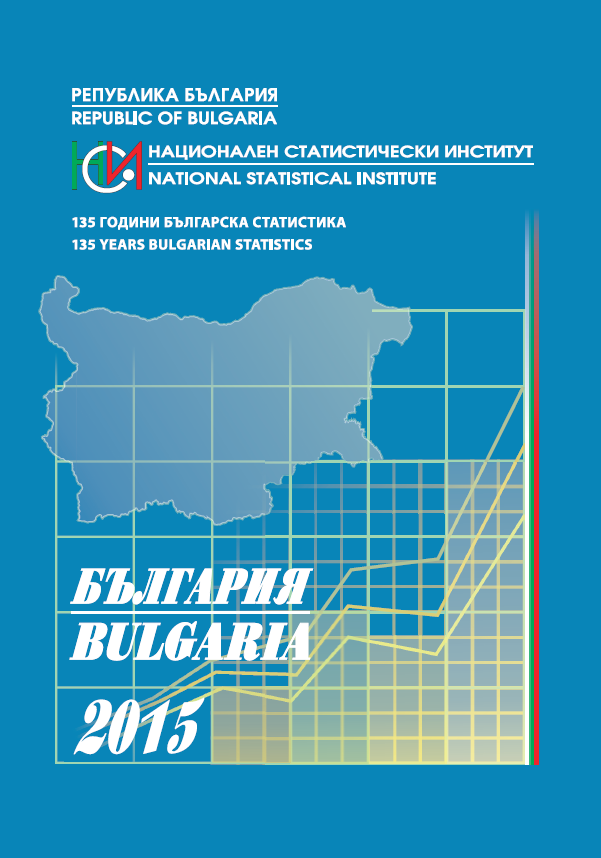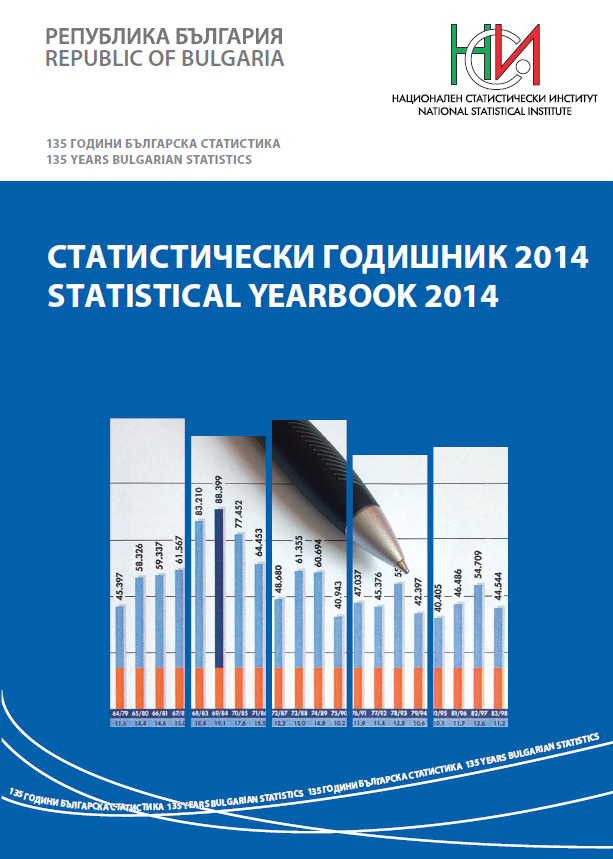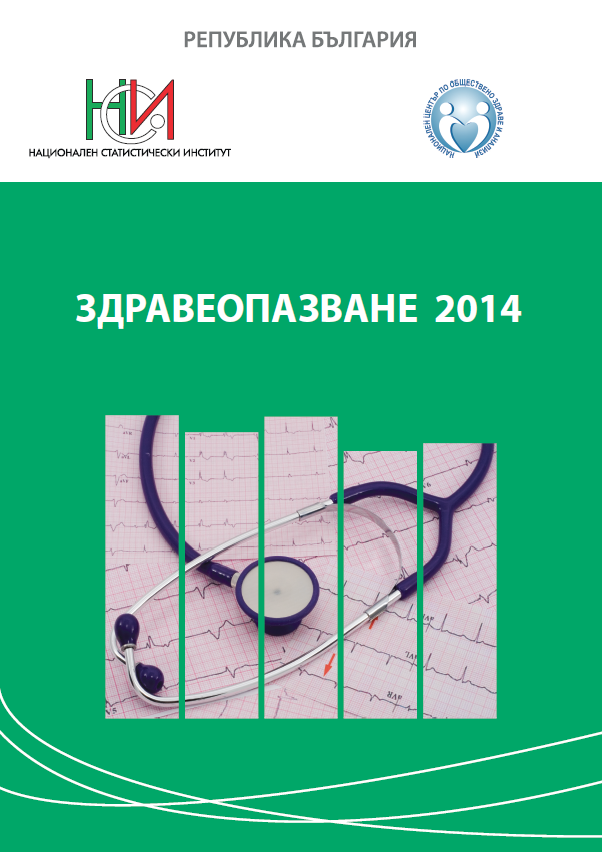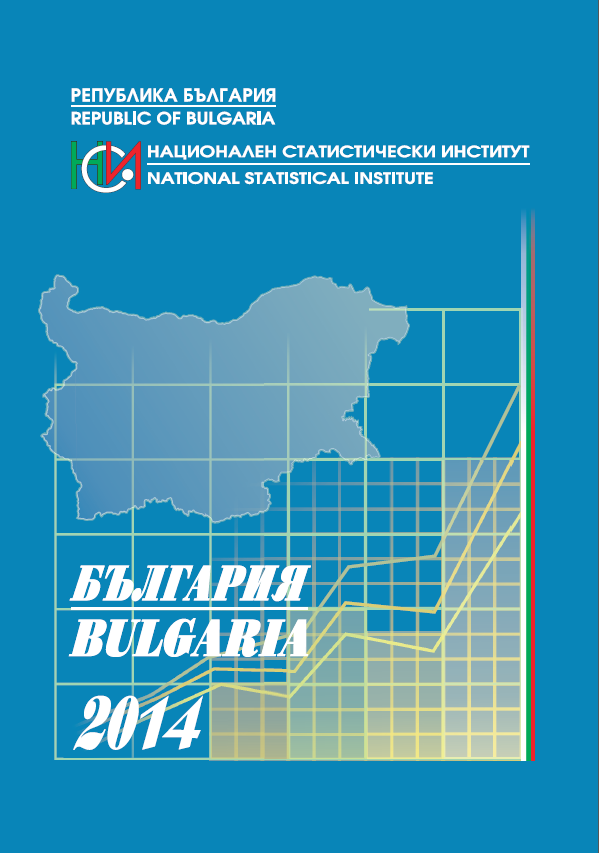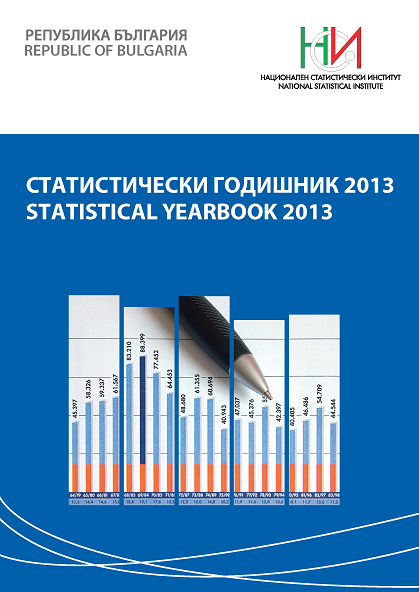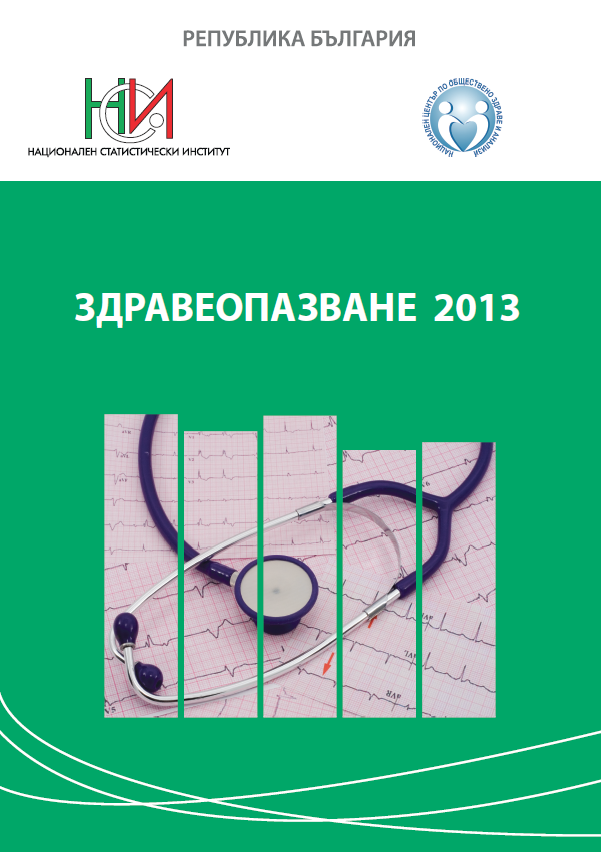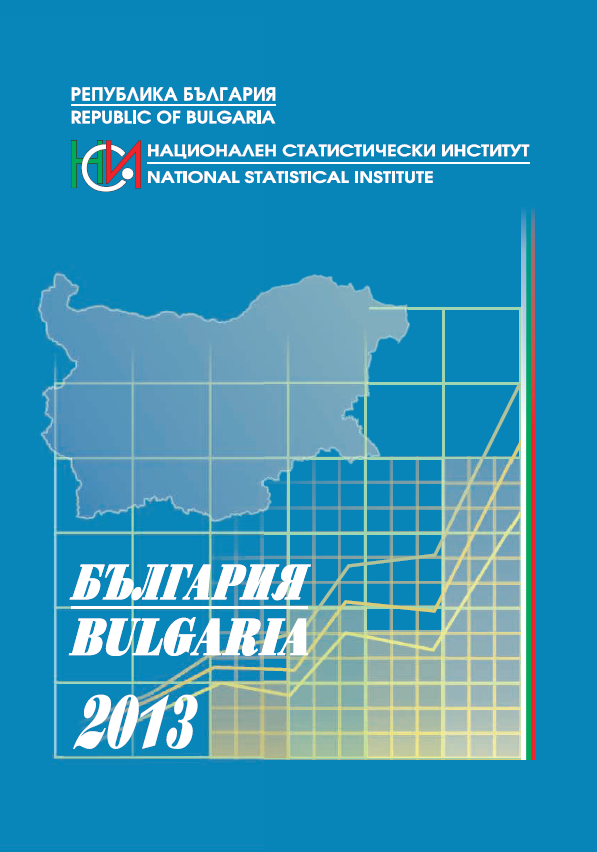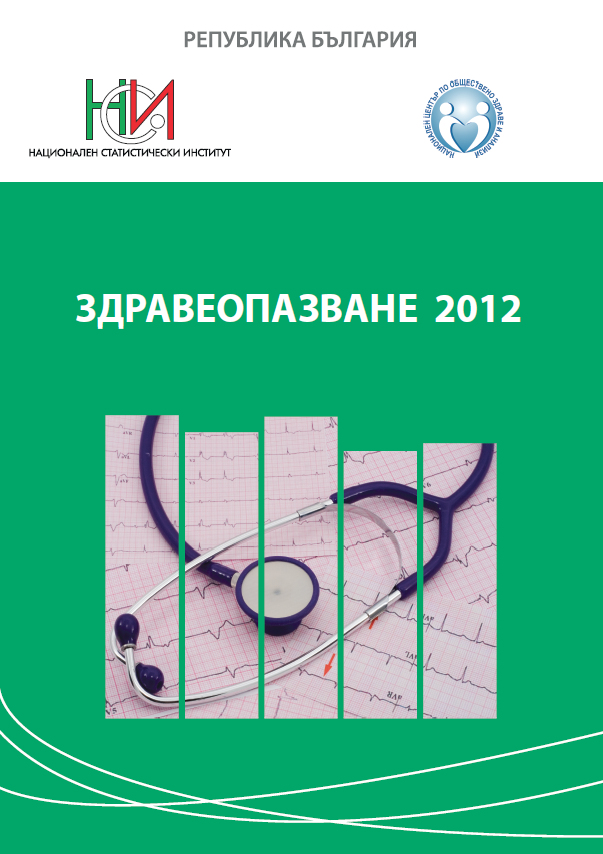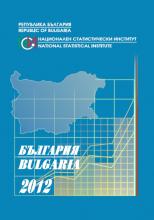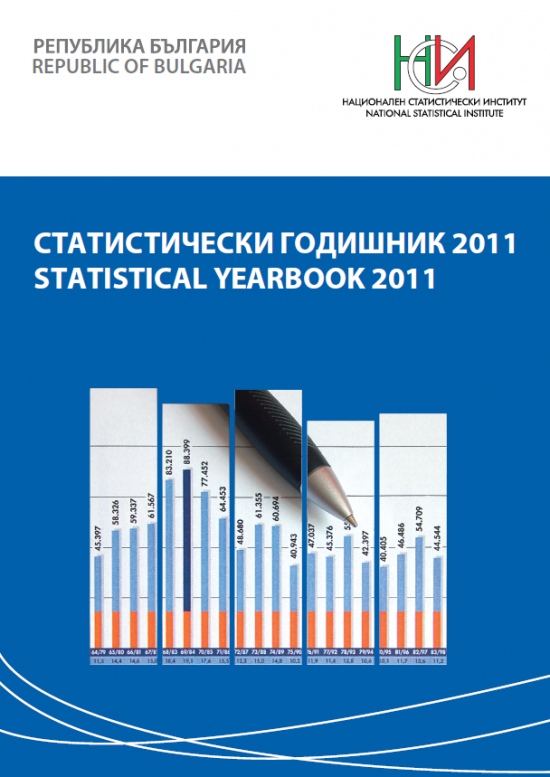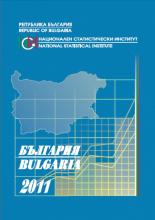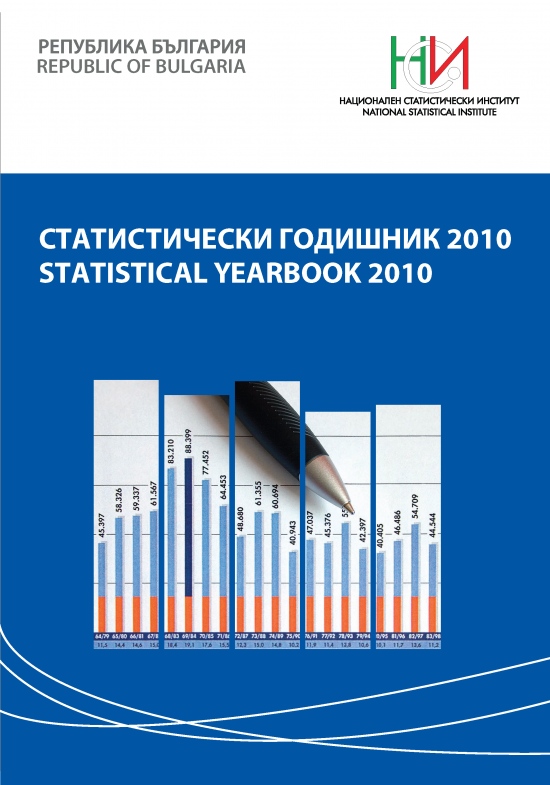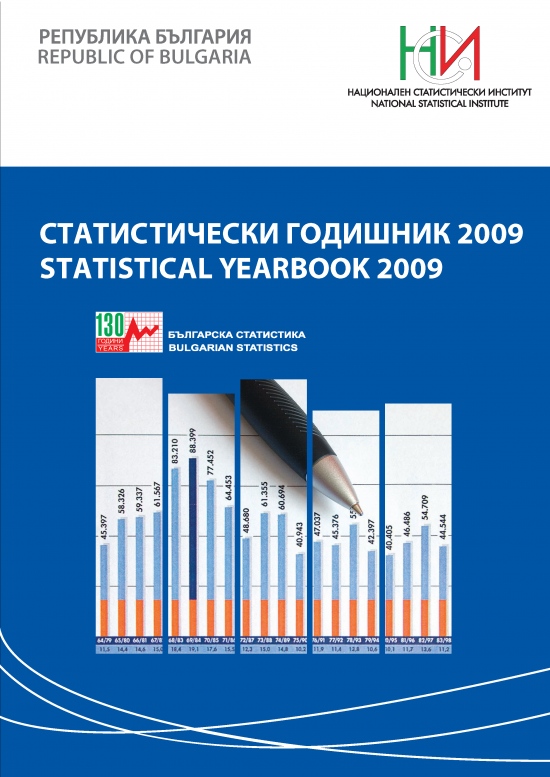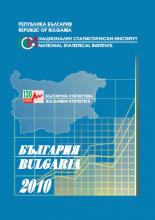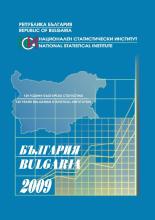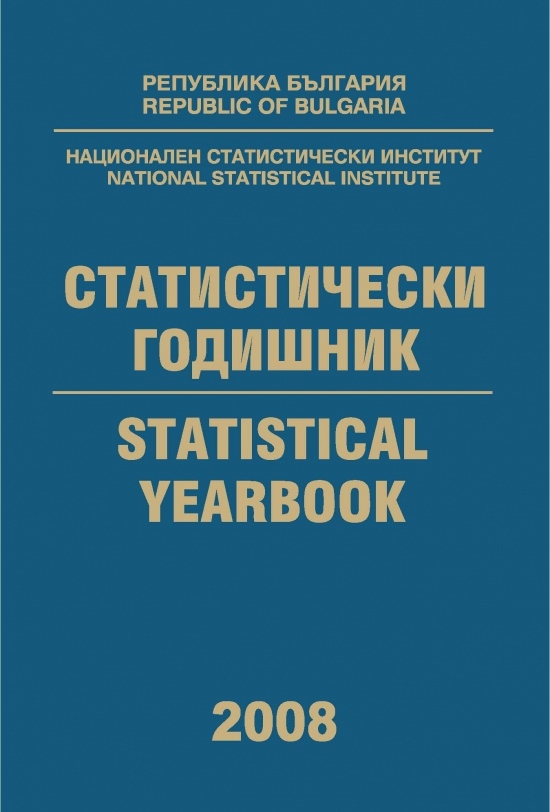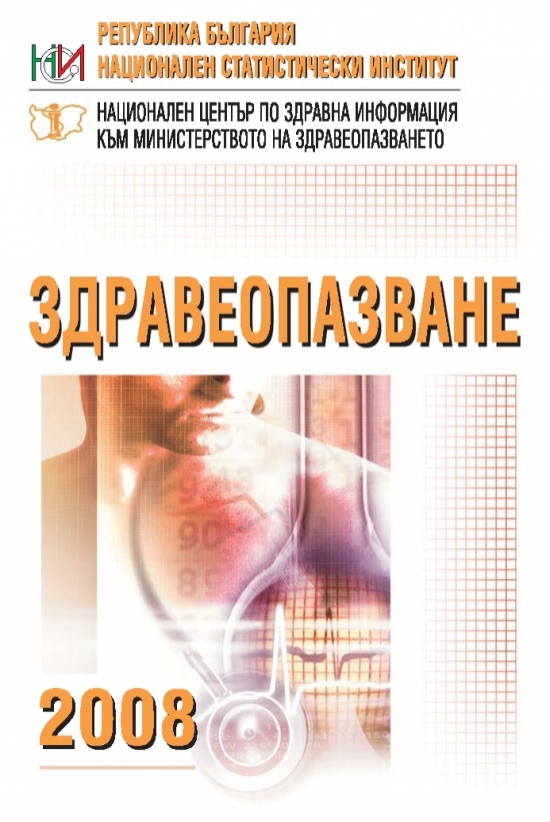System of Health Accounts
| Contact | |
|---|---|
| Contact organisation | National Statistical Institute |
| Contact organisation unit | "Health and Justice Statistics" Department |
| Contact name | Evelin Yordanova |
| Contact person function | Head of department |
| Contact mail address | 2, P. Volov Str.; 1038 Sofia, Bulgaria |
| Contact email address | |
| Contact phone number | +359 2 9857 459 |
| Contact fax number | |
| Metadata update | |
| Metadata last certified | 19 July 2024 |
| Metadata last posted | 19 July 2024 |
| Metadata last update | 19 July 2024 |
| Statistical presentation | |
| Data description | System of Health Accounts is being developed as a statistical system with repetitive current calculations and production of statistical information in accordance with a harmonized methodology and standard classifications. System of Health Accounts is an internationally accepted statistical system for description, classification and analysis of health care expenditure and sources of funding. The application of this statistical system aims to assess all health care expenditure - both public and household, spending of non-profit organizations - foundations, associations, private health insurance funds of enterprises for activities in labour medicine. The main objectives of the System of Health Account are:
SHA provides statistical information at national level on health expenditure by type of provider; by functions according to the aims of the medical activities (curative care, rehabilitation, clinical laboratory, sanitary transport, etc.) and according to the financial sources. The definitions and classifications of the System of Health Accounts, Manual v.1.0. are followed for the period from 2010 to 2013, and for 2013 - 2021 data - the definitions and classifications of the System of Health Accaunts, ver. 2011. In addition, 2011 and 2012 data are elaborated according to the SHA, ver. 2011 requirements and following the requirements of "System of National Accounts, 2010" (SNA2010) and revisions done. During the process of 2018 data compilation, a revision was made in respect to the 2013 – 2017 data due to the inclusion of a new data source and the additional methodological work performed regarding the household expenditures estimation in order to improve the quality and comparability of the data. During the process of 2019 data compilation, a revision was made in respect to the 2017 NHIF data. In accordance with the requirements of Commission Regulation 359/2015 and Eurostat methodological guidelines the expenditure in the revised tables are provided on an “accrual” principle, i.е. in the year when the activities were carried out, not when they were paid for. Since 2020 - Expenditures on providing personal assistance for people with disability in accordance with the Personal Assistance Act (new legislation) are included. Expenditure on aids, devices, equipment and medical devices outside the scope of the compulsory health insurance, determined individually with a medical document issued by the medical advisory committees on the basis of their specific needs, regulated in the Persons with Disabilities Act are included as well. During the process of data compilation, since 2020 EU funds are also included, including those aiming to overcome the consequences of the Covid-19 pandemic. Since 2021 - expenditure on the service "Assistant support" in accordance with the Social Services Act as well as households’ expenditure for outpatient establishments for health care' expenditure (Medical-Treatment Facilities Act) are included. Expenditure on providing non-invasive rapid antigen tests to detect SARS-CoV-2 for students in schools which, according to the methodological requirements, fall within the scope of the study are also included. During the process of 2022 data compilation, a revision was made in respect to the 2021 data and the costs of the purchased doses of COVID-19 vaccines placed during the reporting year has been added. |
| Classification system | The System of Health Accounts is built using the International Classification for Health Accounts by applying three specific classifications:
Methodology and classifications have been developed by Eurostat, the Organisation for Economic Cooperation and Development and the World Health Organization. |
| Sector coverage | All institutional and analytical statistical units that have functions according to the SHA classification of functions, regardless of whether they are in the statistical practice units of the Health sector as economic activities are included. Data is compilated only on national level. |
| Statistical concepts and definitions | Health care boundaries Determining the health care boundaries is supposed by the objectives of the SHA as a statistical system for representing the health expenditure of society as a whole and not just the healthcare system. The main criteria for defining the health care boundaries are as follow:
The development of the SHA methodologically starts with the definition of the goods and services whose final consumption forms the Healthcare sector. According to the SHA methodology the total health expenditures measure the final use of these goods and services plus capital investments in institutions providing health services - those where healthcare is a predominant activity. The difference with the system of national accounts is that the health accounts include institutional and analytical statistical units that have functions according to the SHA classification of functions, regardless of whether they are in the statistical practice units of the Health sector as economic activities. All primary and secondary healthcare providers has to be included, regardless of whether they are classified by national statistics as statistical units of the Health sector. System of Health Accounts is being developed in three subsystems. Subsystems are designed so that the aggregated tables are obtained by a detailed allocation of expenditure by function, by providers and allocation of functions by providers in separate tables. The total expenditure is the sum of current and capital expenditure. Total health expenditure includes both expenditure made by the public and private sectors. The expenditure of the public sector includes general government, including public social security funds:
According to the methodological requirements of the SHA, ver.1.0 the expenditure of the private sector include:
According to the methodological requirements of the SHA, ver. 2011 expenditures for Voluntary health care insurance and enterprises' and organisations' expenditures for labour medical activities are separated from private sector in a separate Voluntary Health Care Payment Schemes.
Classification of healthcare providers (ICHA-HP) Classification of healthcare providers aims reclassification of national institutions in the health sector in internationally comparable and relevant categories of providers of health services. Classification of providers of health care services includes units in which the production of health services is a major activity and those in which the production of health care is a secondary activity. As providers of health services in SHA are also classified the households in the case of care for a sick family member and care of nursing type.
Classification of Health Care Functions (ICHA-HC) essentially contains two classification attributes: 1. Main purpose/type of medical care or activity:
2. Mode of provision
Through this classification the expenditures on personal and collective healthcare goods and services are analysed. Health care combines (includes) personal health services provided directly to the individual and collective health services which relate to the implementation of tasks of public health such as prevention, prophylactic, health administration and health insurance administration. |
| Statistical unit | Commission Regulation 2021/1901 concerns the collection of data on "current expenditure on healthcare" which is defined as the "final consumption expenditure of resident units on health care goods and services". |
| Statistical population | All institutional and analytical statistical units that have functions according to the SHA classification of functions, regardless of whether they are in the statistical practice units of the Health sector as economic activities are included. |
| Reference area | Territory of the Republic of Bulgaria. |
| Time coverage | 2010 - 2013 (data according to the SHA, ver.1.0); |
| Base period | Not applicable. |
| Unit of measure | |
Million BGN. | |
| Reference period | |
Year | |
| Institutional mandate | |
| Legal acts and other agreements | Regulation (EC) No 1338/2008 of the European Parliament and of Council of 16 December 2008 on Community statistics on public health and health and safety at work. |
| Data sharing | In accordance with the basic principles and strategy for international cooperation in the field of health statistics, in December 2006 the Organization for Economic Cooperation and Development, the World Health Organisation and Eurostat launched a joint collection of information according the system of health accounts through a standardized questionnaire. Since 2021 data are provided to all three institutions in line with the Regulation (EU) 2021/1901. |
| Confidentiality | |
| Confidentiality - policy |
|
| Confidentiality - data treatment | Individual data are not published in accordance with article 25 of the Law on Statistics. The publishing of individual data can be performed only in accordance with article 26 of the same law. |
| Release policy | |
| Release calendar | The date of the statistical information release is shown in the Release Calendar presenting the results of the statistical surveys carried out by the National Statistical Institute. Statistical information by system of health accounts is published annually: 22 months after the expiration of the relevant reference period and after completion of the procedure on data validation by the international team of experts from Eurostat, OECD and WHO. |
| Release calendar access | The calendar is available on the NSI website: https://www.nsi.bg/en/node/480. |
| User access | Data on System for health accounts are published on the website of NSI, section Health in accordance with the Law on Statistics (Chapter 5) and the European Statistics Code of Practice, respecting professional independence and aiming objectivity and transparency, in which all users are treated fairly. |
| Frequency of dissemination | |
Annually | |
| Accessibility and clarity | |
| News release | Not applicable. |
| Publications | Not applicable. |
| On-line database | Detailed data on the system of health accounts are available to all users on the NSI website under the heading Health - System of Health Accounts: https://www.nsi.bg/en/node/5568. Online on Eurostat database. |
| Micro-data access | Not available. |
| Other | Information service on request, according to the Rules for the dissemination of statistical products and services in NSI. |
| Documentation on methodology |
|
| Quality documentation | Quality report. |
| Quality management | |
| Quality assurance | The National Statistical Institute as an authoritie responsible for SHA data collection is working to ensure that the statistical practices used to compile national health accounts are in compliance with SHA methodological requirements and that good practices in the field are being followed, according to the methodology underlined in the SHA 2011 Manual. Integrated quality and security management system has been implemented in accordance with the requirements of BDS EN ISO 9001: 2015 and BDS EN ISO 27001: 2017. The certificate fully meets all international requirements and guarantees the quality of the processes and information security of the entire statistical and information infrastructure of the NSI, both at national and regional levels. |
| Quality assessment | The quality of the data is subject to the way, in which health care provision is organised in countrie, and which information is available to and collected by the respective institutions. The National Statistical Institute is continuously working to maintain and improve the quality and the comparability of SHA data. |
| Relevance | |
| User needs | Health accounts are increasingly expected to provide inputs (along with other statistical information) into improved analytical tools to monitor and assess health system performance. One high priority is to develop reliable, timely data that is comparable both across countries and over time. This is indispensable for tracking trends in health spending and the factors driving it, which can in turn be used to compare it across countries and to project how it will grow in the future. Health accounts are thus used in two main ways: internationally, where the emphasis is on a selection of internationally comparable expenditure data, and nationally, with more detailed analyses of health care spending and a greater emphasis on comparisons over time. Health accounts are crucial for both of these. |
| User satisfaction | Not applicable. |
| Completeness | Not applicable. |
| Accuracy and reliability | |
| Overall accuracy | Not applicable. |
| Sampling error | Not applicable. |
| Non-sampling error | Not applicable. |
| Timeliness and punctuality | |
| Timeliness | The data are provided to Eurostat, WHO and OECD in accordance with the deadline set out in Commission Regulation 2021/1901. Once the validation process has been successfully completed, the data is published - T + 20 months or earlier. |
| Punctuality | Data are disseminated according to the Release Calendar presenting the results of the statistical surveys carried out by the National Statistical Institute - usually T+22 or once the validation process has been successfully completed. |
| Coherence and comparability | |
| Comparability - geographical | Not applicable. |
| Comparability - over time | 2010 - 2013 - data according to the SHA, ver.1.0; 2011 - 2022 - data according to the SHA, ver. 2011. Since 2013, there is a break in time series. The data are comparable for the period 2013 – 2022. |
| Coherence - cross domain | Not applicable. |
| Coherence - internal | The data are reconciled. Aggregate tables are obtained by a detailed allocation of expenses by function, by providers and about functions by providers in separate tables. |
| Cost and burden | |
Not applicable. | |
| Data revision | |
| Data revision - policy | Where a new source of information is identified and used, the data for previous years shall be revised if possible. |
| Data revision - practice | 2011 and 2012 data are revised according to the System of Health Accaunts, ver. 2011 requirements. In addition, 2011 and 2012 data are elaborated following the requirements of "System of National Accounts, 2008" (SNA2008) and revisions done. During the process of 2018 data compilation, a revision was made in respect to the 2013 – 2017 data due to the inclusion of a new data source and the additional methodological work performed regarding the household expenditures estimation in order to improve the quality and comparability of the data. During the process of 2019 data compilation, a revision was made in respect to the 2017 NHIF data. In accordance with the requirements of Commission Regulation 359/2015 and Eurostat methodological guidelines the expenditure in the revised tables are provided on an “accrual” principle, i.е. in the year when the activities were carried out, not when they were paid for. During the process of 2022 data compilation, a revision was made in respect to the 2021 data and the costs of the purchased doses of COVID-19 vaccines placed during the reporting year has been added. |
| Statistical processing | |
| Source data |
Since 2021 National Center for Public Health and Analyses at the Ministry of Health statistical data on the immunizations and reimmunizations carried out in medical and health care facilities are used to estimate the expenditures of households for voluntary vaccinations. |
| Frequency of data collection | Annually |
| Data collection | Exhaustive for all units. |
| Data validation | In order to ensure consistency and completeness of the results, the data is validated at national level as follows:
At the next stage data is validated by a team of experts from the three organizations - Eurostat, WHO and OECD. Data validation is performed as follow:
|
| Data compilation | Construction of the System of health accounts is done by usage of “bottom-up” approach, i.e. working with primary data by making a compilation, balance sheet according the three classifications. Rules of arithmetic and logical sequence hitch between the three subsystems are applied.
Household expenditures estimation Business statistical surveys (annual records on accountancy and statistical reports) conducted by NSI are the basic data source: All enterprises in the country that submit “Annual report of non-trade enterprises” and are classified in 86, 87 and 32.50 according to the Classification of Economic Activities (NACE.BG-2008) are exhaustively covered. Units are reclassified in specially developed tables in accordance with the Classification of healthcare providers (ICHA-HP). For assessment of the coverage of the units as well as the correct classification of providers according to the methodological requirements of the SHA, information from the NSI exhaustive survey "Inpatient and outpatient health establishments and other health establishments" is used. For establishments outside the business statistical surveys coverage, information is based on expert estimation. Data are proceeded case by case in order to classify the revenue from population data in accordance to the Classification of Health Care Functions (ICHA-HC). Generally the National Accounts estimation on household’s individual consumption of health services as well as HBS data on household expenditure are taken into account and a cross-validation between results obtained from NSI statistical surveys is done. Concerning HC5 Medical goods estimation - Estimations are done based on retail sales by group of goods for the group "Pharmaceuticals, medical and orthopaedic goods" according to the Classification COICOP and NACE code of the enterprises. NACE codes that are covered: 21, 26, 46, 47.1, 47.2, 47.73, 47.74, 47.78. The estimation is based on the methodological requirements of the SHA 2011 Manual. Since 2020 - Register of persons performing activities for the provision of medical devices and aids, devices and equipment for people with disabilities is used in order to verify the expenditures estimation for medical devices (HC5.2) payed by the households (HF3). Since 2021 - National Center for Public Health and Analyzes at the Ministry of Health exhaustive annual survey on the immunizations and reimmunizations carried out in the medical and health facilities is used in order to verify and balanced the HC5.1 expenditure payed by HF3. Household expenditures information broken down by providers and by function should be balanced.
Covid-19 current expenditures estimation Since 2020, in accordance with the System of Health Accounts’ methodological requirements in order comparability of statistical information at the EU level to be enshured, the following public expenditures, including EU funds (HF1), related to prevent the spread of COVID-19 has been included:
Expenditures on testing for patients with and without symptoms in hospital establishments could not be separated and are included in HC1. Expenditures on personal protective equipment (masks, gloves, protective clothing, protective glasses) for the medical establishments, as well as disinfectants (personal and for the premises), consumables, reagents, medicines, PCR tests, antigen tests, etc.) are allocated to curative care (НС1). Since 2021 expenditure on purchasing COVID-19 vaccines are included - only the costs of the doses placed during the reporting year. MH and NHIF expenditure on the activities of the COVID-19 vaccines placement are included as well. According to the SHA requirements expenditure of purchasing the types and quantities of state reserves necessary to overcome the consequences of a crisis situation are not included. Household’s COVID-19 related expenditures cannot be separated from the overall estimate of household expenditure. |
| Adjustment | Not applicable. |
| Comment | |
ESS Standard for Quality Reports Structure (ESQRS)
| Contact | |||||||||||||||||||||||||||||||||||||||||
|---|---|---|---|---|---|---|---|---|---|---|---|---|---|---|---|---|---|---|---|---|---|---|---|---|---|---|---|---|---|---|---|---|---|---|---|---|---|---|---|---|---|
| Contact organisation | National Statistical Institute | ||||||||||||||||||||||||||||||||||||||||
| Contact organisation unit | "Health and Justice Statistics" Department | ||||||||||||||||||||||||||||||||||||||||
| Contact name | Evelin Yordanova | ||||||||||||||||||||||||||||||||||||||||
| Contact person function | Head of department | ||||||||||||||||||||||||||||||||||||||||
| Contact mail address | 2, P. Volov Str.; 1038 Sofia, Bulgaria | ||||||||||||||||||||||||||||||||||||||||
| Contact email address | |||||||||||||||||||||||||||||||||||||||||
| Contact phone number | +359 2 9857 459 | ||||||||||||||||||||||||||||||||||||||||
| Contact fax number | |||||||||||||||||||||||||||||||||||||||||
| Statistical presentation | |||||||||||||||||||||||||||||||||||||||||
| Data description | System of Health Accounts is being developed as a statistical system with repetitive current calculations and production of statistical information in accordance with a harmonized methodology and standard classifications. System of Health Accounts is an internationally accepted statistical system for description, classification and analysis of health care expenditure and sources of funding. The application of this statistical system aims to assess all health care expenditure - both public and household, spending of non-profit organizations - foundations, associations, private health insurance funds of enterprises for activities in labour medicine. The main objectives of the System of Health Account are:
SHA provides statistical information at national level on health expenditure by type of provider; by functions according to the aims of the medical activities (curative care, rehabilitation, clinical laboratory, sanitary transport, etc.) and according to the financial sources. The definitions and classifications of the System of Health Accounts, Manual v.1.0. are followed for the period from 2010 to 2013, and for 2013 - 2019 data - the definitions and classifications of the System of Health Accaunts, ver. 2011. In addition, 2011 and 2012 data are elaborated according to the SHA, ver. 2011 requirements and following the requirements of "System of National Accounts, 2010" (SNA2010) and revisions done. During the process of 2018 data compilation, a revision was made in respect to the 2013 – 2017 data due to the inclusion of a new data source and the additional methodological work performed regarding the household expenditures estimation in order to improve the quality and comparability of the data. During the process of 2019 data compilation, a revision was made in respect to the 2017 NHIF data. In accordance with the requirements of Commission Regulation 359/2015 and Eurostat methodological guidelines the expenditure in the revised tables are provided on an “accrual” principle, i.е. in the year when the activities were carried out, not when they were paid for. Accounting period: Health expenditure and financing data pertain to the calendar year (1 January to 31 December). The time coverage of this Quality report is 2014 to 2016 reference years. | ||||||||||||||||||||||||||||||||||||||||
| Classification system | The System of Health Accounts is built using the International Classification for Health Accounts by applying three specific classifications:
Methodology and classifications have been developed by Eurostat, the Organisation for Economic Cooperation and Development and the World Health Organization. | ||||||||||||||||||||||||||||||||||||||||
| Sector coverage | All institutional and analytical statistical units that have functions according to the SHA classification of functions, regardless of whether they are in the statistical practice units of the Health sector as economic activities are included. Data is compilated only on national level. | ||||||||||||||||||||||||||||||||||||||||
| Statistical concepts and definitions | Health care boundaries Determining the health care boundaries is supposed by the objectives of the SHA as a statistical system for representing the health expenditure of society as a whole and not just the healthcare system. The main criteria for defining the health care boundaries are as follow:
The development of the SHA methodologically starts with the definition of the goods and services whose final consumption forms the Healthcare sector. According to the SHA methodology the total health expenditures measure the final use of these goods and services plus capital investments in institutions providing health services - those where healthcare is a predominant activity. The difference with the system of national accounts is that the health accounts include institutional and analytical statistical units that have functions according to the SHA classification of functions, regardless of whether they are in the statistical practice units of the Health sector as economic activities. All primary and secondary healthcare providers has to be included, regardless of whether they are classified by national statistics as statistical units of the Health sector. System of Health Accounts is being developed in three subsystems. Subsystems are designed so that the aggregated tables are obtained by a detailed allocation of expenditure by function, by providers and allocation of functions by providers in separate tables. The total expenditure is the sum of current and capital expenditure. Total health expenditure includes both expenditure made by the public and private sectors. The expenditure of the public sector includes general government, including public social security funds:
According to the methodological requirements of the SHA, ver.1.0 the expenditure of the private sector include:
According to the methodological requirements of the SHA, ver. 2011 expenditures for Voluntary health care insurance and enterprises' and organisations' expenditures for labour medical activities are separated from private sector in a separate Voluntary Health Care Payment Schemes.
Classification of healthcare providers (ICHA-HP) Classification of healthcare providers aims reclassification of national institutions in the health sector in internationally comparable and relevant categories of providers of health services. Classification of providers of health care services includes units in which the production of health services is a major activity and those in which the production of health care is a secondary activity. As providers of health services in SHA are also classified the households in the case of care for a sick family member and care of nursing type.
Classification of Health Care Functions (ICHA-HC) essentially contains two classification attributes: 1. Main purpose/type of medical care or activity:
2. Mode of provision
Through this classification the expenditures on personal and collective healthcare goods and services are analysed. Health care combines (includes) personal health services provided directly to the individual and collective health services which relate to the implementation of tasks of public health such as prevention, prophylactic, health administration and health insurance administration. | ||||||||||||||||||||||||||||||||||||||||
| Statistical unit | Commission Regulation 2015/359 concerns the collection of data on "current expenditure on healthcare" which is defined as the "final consumption expenditure of resident units on health care goods and services". | ||||||||||||||||||||||||||||||||||||||||
| Statistical population | All institutional and analytical statistical units that have functions according to the SHA classification of functions, regardless of whether they are in the statistical practice units of the Health sector as economic activities are included. SHA focuses on the consumption of health care goods and services by the resident population irrespective of where this takes place. This implies the inclusion of imports (from non-resident providers) and the exclusion of exports (health care goods and services provided to non-residents). | ||||||||||||||||||||||||||||||||||||||||
| Reference area | Territory of the Republic of Bulgaria. | ||||||||||||||||||||||||||||||||||||||||
| Time coverage | 2010 - 2013 (data according to the SHA, ver.1.0); | ||||||||||||||||||||||||||||||||||||||||
| Base period | Not applicable. | ||||||||||||||||||||||||||||||||||||||||
| Statistical processing | |||||||||||||||||||||||||||||||||||||||||
| Source data |
| ||||||||||||||||||||||||||||||||||||||||
| Frequency of data collection | Annually | ||||||||||||||||||||||||||||||||||||||||
| Data collection | Exhaustive for all units. The data is provided to Eurostat, WHO and OECD in accordance with the deadline set out in Commission Regulation 359/2015. Once the validation process has been successfully completed, the data is published - T + 22 months | ||||||||||||||||||||||||||||||||||||||||
| Data validation | In order to ensure consistency and completeness of the results, the data is validated at national level as follows:
At the next stage data is validated by a team of experts from the three organizations - Eurostat, WHO and OECD. Data validation is performed as follow: 1. Consistency of the data between tables; 2. Consistency of the data within tables, including a presence of negative values or atypical entries; 3. The growth rates against the previous year. | ||||||||||||||||||||||||||||||||||||||||
| Data compilation | Construction of the System of health accounts is done by usage of “bottom-up” approach, i.e. working with primary data by making a compilation, balance sheet according the three classifications. Rules of arithmetic and logical sequence hitch between the three subsystems are applied.
Household expenditures estimation Business statistical surveys (annual records on accountancy and statistical reports) conducted by NSI are the basic data source: All enterprises in the country that submit “Annual report of non-trade enterprises” and are classified in 86, 87 and 32.50 according to the Classification of Economic Activities (NACE.BG-2008) are exhaustively covered. Units are reclassified in specially developed tables in accordance with the Classification of healthcare providers (ICHA-HP). For assessment of the coverage of the units as well as the correct classification of providers according to the methodological requirements of the SHA, information from the NSI exhaustive survey "Inpatient and outpatient health establishments and other health establishments" is used. For establishments outside the business statistical surveys coverage, information is based on expert estimation. Data are proceeded case by case in order to classify the revenue from population data in accordance to the Classification of Health Care Functions (ICHA-HC). Generally the National Accounts estimation on household’s individual consumption of health services as well as HBS data on household expenditure are taken into account and a cross-validation between results obtained from NSI statistical surveys is done. Concerning HC5 Medical goods estimation - Estimations are done based on retail sales by group of goods for the group "Pharmaceuticals, medical and orthopaedic goods" according to the Classification COICOP and NACE code of the enterprises. NACE codes that are covered: 21, 26, 46, 47.1, 47.2, 47.73, 47.74, 47.78. The estimation is based on the methodological requirements of the SHA 2011 Manual. Household expenditures information broken down by providers and by function should be balanced. | ||||||||||||||||||||||||||||||||||||||||
| Adjustment | Not applicable. | ||||||||||||||||||||||||||||||||||||||||
| Quality management | |||||||||||||||||||||||||||||||||||||||||
| Quality assurance | The National Statistical Institute as an authoritie responsible for SHA data collection is working to ensure that the statistical practices used to compile national health accounts are in compliance with SHA methodological requirements and that good practices in the field are being followed, according to the methodology underlined in the SHA 2011 Manual. | ||||||||||||||||||||||||||||||||||||||||
| Quality assessment | The quality of the data is subject to the way, in which health care provision is organised in countrie, and which information is available to and collected by the respective institutions. The National Statistical Institute is continuously working to maintain and improve the quality and the comparability of SHA data. In accordance with the requirements of Commission Regulation 1338/2008 every five years is provided the a report on the quality. | ||||||||||||||||||||||||||||||||||||||||
| Relevance | |||||||||||||||||||||||||||||||||||||||||
| User needs | Health accounts are increasingly expected to provide inputs (along with other statistical information) into improved analytical tools to monitor and assess health system performance. One high priority is to develop reliable, timely data that is comparable both across countries and over time. This is indispensable for tracking trends in health spending and the factors driving it, which can in turn be used to compare it across countries and to project how it will grow in the future. Health accounts are thus used in two main ways: internationally, where the emphasis is on a selection of internationally comparable expenditure data, and nationally, with more detailed analyses of health care spending and a greater emphasis on comparisons over time. Health accounts are crucial for both of these. Data users are state and regional authorities, international organisations, national and foreign users. | ||||||||||||||||||||||||||||||||||||||||
| User satisfaction | NSI conducts a regular statistical survey "Users' satisfaction" which covers all statistical domains. It aims to assess user satisfaction in NSI data provision and to outline the recommendations for future development of statistical system according to the needs of the users. | ||||||||||||||||||||||||||||||||||||||||
| Completeness | For the compulsory variables of the HC categories - the category HC.2.4 "Home-based rehabilitative care" is reported in HC2.3 "Outpatient rehabilitative care". The categories HC.3.2 "Day long-term care (health)" and HC. 3.3 "Outpatient long-term care (health)" are missing. The day long-term care as well as outpatient long-term care are part of the duties of GPs or specialists and the expenditures are reported in HC1. | ||||||||||||||||||||||||||||||||||||||||
| Data completeness - rate | Table HPxHF = 90.9% Table HCxHP = 86.7% Table HCxHF = 79.3% | ||||||||||||||||||||||||||||||||||||||||
| Accuracy and reliability | |||||||||||||||||||||||||||||||||||||||||
| Overall accuracy | The quality of the data depends significantly on the quality of the primary data sources. | ||||||||||||||||||||||||||||||||||||||||
| Sampling error | Not applicable. | ||||||||||||||||||||||||||||||||||||||||
| Sampling errors - indicators | Not applicable. | ||||||||||||||||||||||||||||||||||||||||
| Non-sampling error | Not applicable. | ||||||||||||||||||||||||||||||||||||||||
| Coverage error | Overcoverage - Health care goods and services by non-residents are included. Undercoverage - There is some underestimation of the LTC expenditure. The distinction between health and social long-term care in Bulgaria is based on national legislation and NACE classification. Within health care, only hospices provide long-term health care as a main function. Palliative care in hospitals have been classified as curative care as a function, rather than long-term care. Homes for the disabled and elderly – which come under social care establishments – do not provide on-site medical care. Medical treatment is provided under contract by GPs and other specialists, as for the rest of the population. All other community and residential services come under the umbrella of social services. An under-coverage exists in OOP payments. Underground/informal/illegal health services and goods are not included. At this stage we are not able to report these payments. | ||||||||||||||||||||||||||||||||||||||||
| Over-coverage - rate | Overcoverage - Health care goods and services by non-residents are included. Undercoverage - There is some underestimation of the LTC expenditure. The distinction between health and social long-term care in Bulgaria is based on national legislation and NACE classification. Within health care, only hospices provide long-term health care as a main function. Palliative care in hospitals have been classified as curative care as a function, rather than long-term care. Homes for the disabled and elderly – which come under social care establishments – do not provide on-site medical care. Medical treatment is provided under contract by GPs and other specialists, as for the rest of the population. All other community and residential services come under the umbrella of social services. An under-coverage exists in OOP payments. Underground/informal/illegal health services and goods are not included. At this stage we are not able to report these payments. | ||||||||||||||||||||||||||||||||||||||||
| Common units - proportion | If double-counting of expenditure is detected it is removed and consolidated. | ||||||||||||||||||||||||||||||||||||||||
| Measurement error | National data validation is carried out - analysis of trends, growth rates and anomalies. In case of errors detected, the data are revised. | ||||||||||||||||||||||||||||||||||||||||
| Non response error | Not applicable. | ||||||||||||||||||||||||||||||||||||||||
| Unit non-response - rate | Not applicable. | ||||||||||||||||||||||||||||||||||||||||
| Item non-response - rate | Not applicable. | ||||||||||||||||||||||||||||||||||||||||
| Processing error | National data validation is carried out - analysis of trends, growth rates and anomalies and cross-validation between different data sources. In case of errors detected, the data are revised. | ||||||||||||||||||||||||||||||||||||||||
| Imputation - rate | Not applicable. | ||||||||||||||||||||||||||||||||||||||||
| Model assumption error | Not applicable. | ||||||||||||||||||||||||||||||||||||||||
| Seasonal adjustment | Not applicable. | ||||||||||||||||||||||||||||||||||||||||
| Data revision - policy | There are two main types of revisions:
| ||||||||||||||||||||||||||||||||||||||||
| Data revision - practice | 2011 and 2012 data are revised according to the System of Health Accaunts, ver. 2011 requirements. In addition, 2011 and 2012 data are elaborated following the requirements of "System of National Accounts, 2008" (SNA2008) and revisions done. During the process of 2018 data compilation, a revision was made in respect to the 2013 – 2017 data due to the inclusion of a new data source and the additional methodological work performed regarding the household expenditures estimation in order to improve the quality and comparability of the data. During the process of 2019 data compilation, a revision was made in respect to the 2017 NHIF data. In accordance with the requirements of Commission Regulation 359/2015 and Eurostat methodological guidelines the expenditure in the revised tables are provided on an “accrual” principle, i.е. in the year when the activities were carried out, not when they were paid for. | ||||||||||||||||||||||||||||||||||||||||
| Data revision - average size | Changes resulting from data revisions in the last years range from -0.1% to + 0.04% (grow rates) depending on the kind of revision - refers to the period covered by the last quality report (2014-2016). | ||||||||||||||||||||||||||||||||||||||||
| Timeliness and punctuality | |||||||||||||||||||||||||||||||||||||||||
| Timeliness | The data are provided to Eurostat, WHO and OECD in accordance with the deadline set out in Commission Regulation 359/2015. Once the validation process has been successfully completed, the data is published - T + 22 months | ||||||||||||||||||||||||||||||||||||||||
| Time lag - first results | Not applicable. | ||||||||||||||||||||||||||||||||||||||||
| Time lag - final results | |||||||||||||||||||||||||||||||||||||||||
| Punctuality | Data are disseminated according to the Release Calendar presenting the results of the statistical surveys carried out by the National Statistical Institute. | ||||||||||||||||||||||||||||||||||||||||
| Punctuality - delivery and publication | Transmission to Eurostat, WHO and OECD: 30 April in year t for figures on year t-2. | ||||||||||||||||||||||||||||||||||||||||
| Coherence and comparability | |||||||||||||||||||||||||||||||||||||||||
| Comparability - geographical | Not applicable. | ||||||||||||||||||||||||||||||||||||||||
| Asymmetry for mirror flows statistics - coefficient | Not applicable. | ||||||||||||||||||||||||||||||||||||||||
| Comparability - over time | 2010 - 2013 - data according to the SHA, ver.1.0; 2011 - 2019 - data according to the SHA, ver. 2011. Since 2013, there is a break in time series. The data are comparable for the period 2013 – 2019. | ||||||||||||||||||||||||||||||||||||||||
| Length of comparable time series | 2010 - 2013 - data according to the SHA, ver.1.0; 2011 - 2019 - data according to the SHA, ver. 2011. Since 2013, there is a break in time series. The data are comparable for the period 2013 – 2019. | ||||||||||||||||||||||||||||||||||||||||
| Coherence - cross domain | The SHA figures can be reconciled with figures from Business statistics. A full coherence between SHA and ESSPROS is not feasible. Compilation methods for SHA and ESSPROS are different for Bulgarian NSI and therefore data cannot be mapped. | ||||||||||||||||||||||||||||||||||||||||
| Coherence - sub annual and annual statistics | Not applicable. | ||||||||||||||||||||||||||||||||||||||||
| Coherence - National Accounts | Coherence in accounting principles exist. However, as differences in the scope and the concepts used by SHA and National accounts exist, a full coherence is not applicable. | ||||||||||||||||||||||||||||||||||||||||
| Coherence - internal | The data are reconciled. Aggregate tables are obtained by a detailed allocation of expenses by function, by providers and about functions by providers in separate tables.
Atypical entries:
| ||||||||||||||||||||||||||||||||||||||||
| Accessibility and clarity | |||||||||||||||||||||||||||||||||||||||||
| News release | Not applicable. | ||||||||||||||||||||||||||||||||||||||||
| Publications | Not applicable. | ||||||||||||||||||||||||||||||||||||||||
| On-line database | Detailed data on the system of health accounts are available to all users on the NSI website under the heading Health - System of Health Accounts: https://www.nsi.bg/en/node/5568. Online on Eurostat database. | ||||||||||||||||||||||||||||||||||||||||
| Data tables - consultations | Not applicable. | ||||||||||||||||||||||||||||||||||||||||
| Micro-data access | Not available. | ||||||||||||||||||||||||||||||||||||||||
| Other | Information service on request, according to the Rules for the dissemination of statistical products and services in NSI. | ||||||||||||||||||||||||||||||||||||||||
| Metadata - consultations | Not applicable. | ||||||||||||||||||||||||||||||||||||||||
| Documentation on methodology |
| ||||||||||||||||||||||||||||||||||||||||
| Metadata completeness – rate | |||||||||||||||||||||||||||||||||||||||||
| Quality documentation | Quality report. | ||||||||||||||||||||||||||||||||||||||||
| Cost and burden | |||||||||||||||||||||||||||||||||||||||||
Not applicable. | |||||||||||||||||||||||||||||||||||||||||
| Confidentiality | |||||||||||||||||||||||||||||||||||||||||
| Confidentiality - policy |
| ||||||||||||||||||||||||||||||||||||||||
| Confidentiality – data treatment | Individual data are not published in accordance with article 25 of the Law on Statistics. The publishing of individual data can be performed only in accordance with article 26 of the same law. | ||||||||||||||||||||||||||||||||||||||||
| Comment | |||||||||||||||||||||||||||||||||||||||||
Crèches in 2024
The number of detached crèches and groups in kindergartens functioning in the country as of 31.12.2024 was 839, with 33 480 places in them.
The number of children accommodated in crèches at the end of the year was 30 367. 15 635 of them were boys, and 14 732 - girls.
The total number of places in crèches per 100 children aged up to 3 years as of 31.12.2024 was 19.9, and the coverage of children brought up in crèches - 18.0 per 100 children aged up to 3 years.
...In-patient, Out-patient and Other Health Care Establishments as of 31.12.2023
The number of health establishments for hospital aid at the end of 2023 was 341 with 55 724 beds. The number of hospital beds was 864.5 per 100 000 persons of the total population.
The number of out-patient health establishments was 2 237 with 1 307 beds for short term treatment. The number of other health establishments was 149 with 1 742 beds in them.
On a basic contract in the health establishments in the country were practicing:
- 29 911 physicians;
- 7 607 dentists, as 6 583 of them worked in practices that...
Crèches in 2023
The number of detached crèches and groups in kindergartens functioning in the country as of 31.12.2023 was 835, with 33 373 places in them.
The number of children accommodated in crèches at the end of the year was 30 586. 15 810 of them were boys, and 14 776 - girls.
The total number of places in crèches per 100 children aged up to 3 years as of 31.12.2023 was 19.5, and the coverage of children brought up in crèches - 17.9 per 100 children aged up to 3 years.
...In-patient, Out-patient and Other Health Care Establishments as of 31.12.2022
At the end of 2022, the number of health establishments for hospital aid was 341 with 54 707 beds. The number of beds in these establishments has increased by 216, or by 0.4% compared to the previous year.
The number of hospital beds was 848.5 per 100 000 persons of the total population as the highest values of that indicator were registered in districts Pleven (1 184.5 per 100 000 persons of the population), Smolyan (1 135.5) and Plovdiv (1 069.5).
The number of out-patient health establishments was 2 ...
Creches in 2022
The number of detached crèches and groups in kindergartens functioning in the country as of 31.12.2022 was 835, with 33 193 places in them.
The number of children accommodated in crèches at the end of the year was 30 544. 15 857 of them were boys, and 14 687 - girls.
The total number of places in crèches per 100 children aged up to 3 years as of 31.12.2022 was 19.5, and the coverage of children brought up in crèches - 17.9 per 100 children aged up to 3 years.
...In-patient, Out-patient and Other Health Care Establishments as of 31.12.2021
The number of health establishments for hospital aid as of 31.12.2021 was 341 with 54 491 beds. 319 of them were hospitals with 52 246 beds.
The number of out-patient health establishments was 2 133 with 1 285 beds and other health establishments were 151 with 1 939 beds in them.
At the end of 2021 29 604 physicians were in practice under the basic labour contracts in health establishments. Dentists were 7 499, as 6 585 worked in practices that had signed а contract with National Health Insurance Fund. Medical specialists in ‘Healt...
Creches in 2021
The number of detached crèches and groups in kindergartens functioning in the country as of 31.12.2021 was 833, with 32 856 places in them.
The number of children accommodated in crèches at the end of the year was 29 724. 15 347 of them were boys, and 14 377 - girls.
The total number of places in crèches per 100 children aged up to 3 years as of 31.12.2021 was 18.2, and the coverage of children brought up in crèches - 16.5 per 100 children aged up to 3 years.
...European Health Interview Survey - third wave, 2019 (final data)
The National Statistical Institute informs statistical data users that final European Health Interview - wave 3 data are available
The European Health Interview Survey is a part of the European Health Survey System, which aims at measuring on a harmonized basis and with a high degree of comparability among EU Member States, the health status, life style (health determinants) and health care services use of the EU citizens.
In 2019, the Bulgarian NSI participated in the EHIS wave 3 in accordance with the Commission Regulation (EU) No...
In-patient, Out-patient and Other Health Care Establishments as of 31.12.2020
The number of health establishments for hospital aid as of 31.12.2020 was 342 with 54 216 beds. 320 of them were hospitals with 51 991 beds.
The number of out-patient health establishments was 2 098 with 1 296 beds and other health establishments were 149 with 1 935 beds in them.
At the end of 2020 29 717 physicians were in practice under the basic labour contracts in health establishments. Dentists were 7 312, as 6 454 worked in practices that had signed а contract with National Health Insurance Fund. Medical specialists on ‘Health cares’ who worked on a basic labour co...
Creches in 2020
The number of detached crèches and groups in kindergartens functioning in the country as of 31.12.2020 was 838 with 32 575 places in them.
The number of children accommodated in crèches at the end of the year was 29 238. 15 169 of them were boys, and 14 069 - girls.
The total number of places in crèches per 100 children aged up to 3 years as of 31.12.2020 was 17.7 and the coverage of children brought up in crèches - 15.9 per 100 children aged up to 3 years.
...European Health Interview Survey - third wave, 2019 (preliminary data)
The European Health Interview Survey is a part of the European Health Survey System, which aims at measuring on a harmonized basis and with a high degree of comparability among EU Member States, the health status, life style (health determinants) and health care services use of the EU citizens.
The NSI presents preliminary data from the survey conducted at the end of 2019:
NSI presents preliminary results based on the conducted at the end of 2019 EHIS:
- The biggest was the share of persons aged 15 and over who self-assessed their health as ‘good’ (40.7%)...
In-patient, Out-patient and Other Health Care Establishments as of 31.12.2019
The number of health establishments for hospital aid as of 31.12.2019 was 341 with 53 997 beds. 319 of them were hospitals with 51 776 beds.
The number of out-patient health establishments was 2 079 with 1 223 beds and other health establishments were 144 with 1 914 beds in them.
At the end of 2019 29 612 physicians were in practice under the basic labour contracts in health establishments. Dentists were 7 376, as 6 493 worked in practices that had signed contract with National Health Insurance Fund. Medical specialists on ‘Health cares’ who worked on a basic labour cont...
Creches in 2019
The number of detached crèches and groups in kindergartens functioning in the country as of 31.12.2019 was 835 with 33 764 places in them.
The number of children accommodated in crèches at the end of the year was 32 185. 16 677 of them were boys, and 15 508 - girls.
The total number of places in crèches per 100 children aged up to 3 years as of 31.12.2019 was 17.9 and the coverage of children brought up in crèches - 17.1 per 100 children aged up to 3 years.
...In-patient, Out-patient and Other Health Care Establishments as of 31.12.2018
The number of health establishments for hospital aid as of 31.12.2018 was 346 with 53 173 beds. 322 of them were hospitals with 50 927 beds.
The number of out-patient health establishments was 2 066 with 1 253 beds and other health establishments were 145 with 2 086 beds in them.
At the end of 2018 29 667 physicians were in practice under the basic labour contracts in health establishments. Dentists were 7 240, as 6 347 worked in practices that had signed contract with National Health Insurance Fund. Medical specialists on ‘Health cares’ who worked on a basic labour contract in ...
Creches in 2018
The number of detached crèches and groups in kindergartens functioning in the country as of 31.12.2018 was 840 with 33 226 places in them.
The number of children accommodated in crèches at the end of the year was 31 939. 16 449 of them were boys, and 15 490 - girls.
The total number of places in crèches per 100 children aged up to 3 years as of 31.12.2018 was 17.3 and the coverage of children brought up in crèches - 16.6 per 100 children aged up to 3 years.
...In-patient, Out-patient and Other Health Care Establishments as of 31.12.2017
The number of health establishments for hospital aid as of 31.12.2017 was 346 with 52 744 beds. 322 of them were hospitals with 50 519 beds.
The number of out-patient health establishments was 2 043 with 1 263 beds and other health establishments were 144 with 2 179 beds in them.
At the end of 2017 30 078 physicians were in practice under the basic labour contracts in health establishments. Dentists were 8 355, as 7 456 worked in practices that had signed contract with National Health Insurance Fund. Medical specialists on ‘Health cares’ who worked on a basic labour contract in ...
Creches in 2017
The number of detached crèches and groups in kindergartens functioning in the country as of 31.12.2017 was 837 with 32 970 places in them.
The number of children accommodated in crèches at the end of the year was 32 429. 16 738 of them were boys, and 15 691 - girls.
The total number of places in crèches per 100 children aged up to 3 years as of 31.12.2017 was 16.9 and the coverage of children brought up in crèches - 16.6 per 100 children aged up to 3 years.
...In-patient, Out-patient and Other Health Care Establishments as of 31.12.2016
The number of health establishments for hospital aid as of 31.12.2016 was 345 with 51 816 beds. 321 of them were hospitals with 49 589 beds.
The number of out-patient health establishments was 2 029 with 1 163 beds and other health establishments were 140 with 2 193 beds in them.
At the end of 2016 29 539 physicians were in practice under the basic labour contracts in health establishments. Dentists were 8 011, as 7 174 worked in practices that had signed contract with National Health Insurance Fund. Medical specialists on 'Health cares' who worked on a basic labour contract in ...
Creches in 2016
The number of detached crèches and groups in kindergartens functioning in the country as of 31.12.2016 was 829 with 32 611 places in them. The number of places in the country has increased with 571, or with 1.8% compared to the previous year.
The number of children accommodated in crèches at the end of the year was 32 476. 16 851 of them were boys, and 15 625 - girls.
The total number of places in crèches per 100 children aged up to 3 years as of 31.12.2016 was 16.5 and the coverage of children brought up in crèches - 16.4 per 100 children aged up to 3 years.
...European Health Interview Survey - second wave, 2014 (main results)
The survey is a part of the European Health Survey System in the framework of the European Statistical System. The EHIS aims at measuring on a harmonized basis and with a high degree of comparability among EU Member States, the health status, life style (health determinants) and health care services use of the EU citizens.
NSI presents final results based on the conducted in 2014 EHIS.
...In-patient, Out-patient and Other Health Care Establishments as of 31.12.2015 (preliminary data)
According to the preliminary data of the NSI the number of health establishments for hospital aid as of 31.12.2015 was 348 with 51 933 beds. 322 of them were hospitals with 49 028 beds.
The number of out-patient health establishments was 1 915 with 1 044 beds and other health establishments were 136 with 2 394 beds in them.
At the end of 2015 29 093 physicians were in practice under the basic labour contracts in health establishments. Dentists were 7 513 and medical specialists on 'Health cares' - 47 349.
...Creches in 2015
The number of detached crèches and groups in kindergartens functioning in the country as of 31.12.2015 was 812 with 32 040 places in them. The number of places in the country has increased with 1 516, or with 5.0% compared to the previous year.
The number of children accommodated in crèches at the end of the year was 32 124. 16 497 of them were boys, and - 15 627 girls.
...In-patient, Out-patient and Other Health Care Establishments as of 31.12.2014
The number of health establishments for hospital aid as of 31.12.2014 was 349 with 51 505 beds. 323 of them were hospitals with 48 680 beds.
The number of out-patient health establishments was 1 931 with 956 beds and other health establishments were 145 - 3 160 beds in them.
At the end of 2014 28 842 physicians were in practice under the basic labour contracts in health establishments.
For the first time the National Statistical Institute is publishing data on distribution of practicing physicians by sex and age.
Creches in 2014
The number of detached crèches and groups in kindergartens functioning in the country as of 31.12.2014 was 794 with 30 524 places in them. The number of places in the country has increased with 404, or with 1.3% compared to the previous year.
The number of children accommodated in crèches at the end of the year was 31 489. 16 167 of them were boys, and - 15 322 girls.
The coverage of children brought up in crèches at the end of 2014 was 15.8%.
...Homes for Medico-social Care for Children in 2014
At the end of 2014 in Bulgaria there are 29 Homes for medico-social care for children with total capacity of 2 199 places. 975 children are accommodated there - 537 boys (55.1%) and 438 girls (44.9%).
...In-patient, Out-patient and Other Health Care Establishments as of 31.12.2013 (preliminary data)
According to the preliminary data of the NSI the number of health establishments for hospital aid as of 31.12.2013 was 342 with 49 522 beds. 316 of them were hospitals with 46 804 beds. The number of out-patient health establishments was 1 885 with 980 beds and other health establishments were 145 - 3 132 beds in them.
...Creches in 2013
The number of detached crèches and groups in kindergartens functioning in the country as of 31.12.2013 was 770 with 30 120 places in them. 31 199 children were accommodated there at the end of 2013. 16 122 of them were boys, and - 15 077 girls.
...Homes for Medico-social Care for Children in 2013
At the end of 2013 there were 29 Homes for medico-social care for children with total capacity of 2 258 places. The process of deinstitutionalization was continued. 1 204 children were accommodated in them as of 31.12.2013. 670 of them were boys and 534 - girls.
In-patient, Out-patient and Other Health Care Establishments as of 31.12.2012
Creches in 2012
Homes for Medico-social Care for Children in 2012
In-patient, Out-patient and Other Health Care Establishments as of 31.12.2011
Creches in 2011
Homes for Medico-social Care for Children in 2011
In-patient, Out-patient and Other Health Care Establishments in 2010
Creches in 2010
Homes for Medico-social Care for Children in 2010
Health Services 2024
The National Statistical Institute presents to users of statistical information in the field of the social statistics the annual electronic publication Health Services 2024 (in Bulgarian), a joint edition of the National Statistical Institute and the National Center of Public Health and Analyses at the Ministry of Health.
The data sources are the statistical surveys carried out by the both institutions.
In the publication data are systematized as follows:
• Population and demographic process - main demographic indic...
Bulgaria 2024
The National Statistical Institute presents the bilingual (Bulgarian/English) brochure Bulgaria 2024 to the users of statistical information. The brochure is addressed to a wide range of users (international institutions, representatives of business, students, experts etc.) and changes the traditional presentation of statistical information by offering an innovative structure with a parallel translation in English.
The publication contains up-to-date statistical information about the demographic, social and economic development of the country over the 2018 - 2023 ...
Statistical Yearbook 2023
The National Statistical Institute (NSI) has the pleasure to present to the attention of national and foreign users of statistical information the 91-st edition of the ‘Statistical Yearbook of the Republic of Bulgaria’ in printed format.
It provides current statistical information about the demographic, economic and social development of the country for 2017 - 2022 in different territorial and classification aggregations and breakdowns.
According to the Law on Statistics, official source of information in the Republic of Bulgaria is the National Statistical Sys...
Health Services 2023
The National Statistical Institute presents to users of statistical information in the field of the social statistics the annual electronic publication Health Services 2023 (in Bulgarian), a joint edition of the National Statistical Institute and the National Center of Public Health and Analyses at the Ministry of Health.
The data sources are the statistical surveys carried out by the both institutions.
In the publication data are systematized as follows:
• Population and demographic process - main demographic indicators - population number and structures, fert...
Statistical Yearbook 2022
It provides current statistical information about the demographic, economic and social development of the country for 2016 - 2021 in different territorial and classification aggregations and breakdowns.
According to the Law on Statistics, official source of information in the Republic of Bulgaria is the National Statistical ...
Health Services 2022
The data sources are the statistical surveys carried out by the both institutions.
In the publication data are systematized as follows:
• Population and demographic process - main demograp...
Bulgaria 2022
The National Statistical Institute presents the bilingual (Bulgarian/English) brochure Bulgaria 2022 to users of statistical information. The brochure is addressed to a wide range of users (international institutions, business, students, experts etc.) and changes the traditional presentation of statistical information by offering an innovative structure with a parallel translation in English. The publication contains topical statistical information about the demographic, social and economic development of the country over the 2016 - 2021 period. It also includes n...
Statistical Yearbook 2021
It provides current statistical information about the demographic, economic and social development of the country for 2015 - 2020 in different territorial and classification aggregations and breakdowns.
According to the Law on Statistics, official source of information in the Republic of Bulgaria is the ...
Health Services 2021
The data sources are the statistical surveys carried out by the both institutions.
In the publication data are systematized as follows:
• Population and demographic process - main demograp...
Statistical Yearbook 2020
It provides current statistical information about the demographic, economic and social development of the country for 2014 - 2019 in different territorial and classification aggregations and breakdowns.
According to the Law on Statistics, official source of information in the Republic of Bulgaria is the ...
Bulgaria 2021
Health Services 2020
The data sources are the statistical surveys carried out by the both institutions.
In the publication data are systematized as follows:
• Population and demographic process - main demograp...
Statistical Yearbook 2012
Bulgaria 2020
Statistical Yearbook 2019
It provides current statistical information about the demographic, economic and social development of the country for 2013 - 2018 in different territorial and classification aggregations and breakdowns.
According to the Law on Statistics, official source of information in the Republic of Bulgaria is the ...
Health Services 2019
The data sources are the statistical surveys carried out by the both institutions.
In the publication data are systematized as follows:
• Population and demographic process - main demographic indicato...
Statistical Yearbook 2018 in infographics
In 2018, for the first time, we presented the results of the statistical surveys through graphics, images and other visualization tools, which resulted in a positive response among a wide range of users. We believe that this modern way of presenting statistical information will trigger the interest in those who for the first time encounter the meaning of numbers revealing important aspects of socio-economic life.
...Statistical Yearbook 2018
It provides current statistical information about the demographic, economic and social development of the country for 2012 - 2017 in different territorial and classification aggregations and breakdowns.
According to the Law on Statistics, official source of information in the Republic of Bulgaria is the ...
Health Services 2018
The publication Health Services is a joint edition of the National Statistical Institute and the National Centre for Public Health and Analyses at the Ministry of Health.
The data sources are the statistical surveys carried out by the both institutions.
In the publication data are systematized as follows:
• Population and demographic proces...
Statistical Yearbook 2017 in infographics
The publication is intended for a wider audience as statistical data are presented in a plain and easy understandable way.
The current state and changes in the socio-economic and cultural life in the country are presented not in the traditional way in tables and text, but through infographics - images, graphics and other visualization tools.
We belie...
Statistical Yearbook 2017
It provides current statistical information about the demographic, economic and social development of the country for 2012 - 2016 in different territorial and classification aggregations and breakdowns.
According to the Law on Statistics, official source of information in the Republic of Bulgaria is the ...
Bulgaria 2018
Health Services 2017
The publication Health Services is a joint edition of the National Statistical Institute and the National Centre for Public Health and Analyses at the Ministry of Health.
The data sources are the statistical surveys carried out by the both institutions.
In the publication data are systematized as follows:
• Population and demographic proces...
Bulgaria 2017
Statistical Yearbook 2016
It provides current statistical information about the demographic, economic and social development of the country for 2011 - 2015 in different territorial and classification aggregations and breakdowns.
According to the Law on Statistics, official source of information in the Republic of Bulgaria is the ...
Health Services 2016
The data sources are the statistical surveys carried out by the both institutions.
Bulgaria 2016
Statistical Yearbook 2015
It provides current statistical information about the demographic, economic and social development of the country for 2010 - 2014 in different territorial and classification aggregations and breakdowns.
According to the Law on Statistics, official source of information in the Republic of Bulgaria is the ...
Health Services 2015
The data sources are the statistical surveys carried out by the both institutions.
Bulgaria 2015
The National Statistical Institute presents the bilingual (Bulgarian/English) brochure Bulgaria 2015 to users of statistical information. The brochure is addressed to a wide range of users (international institutions, businessmen, students, experts etc.) and changes the traditional presentation of statistical information by offering an innovative structure with a parallel translation in English. The publication contains topical statistical information about the demographic, social and economic development of the country over the 2010 - 2014 period. It also includes non-tra...
Statistical Yearbook 2014
The National Statistical Institute (NSI) has the pleasure to present to the attention of national and foreign users of statistical information the 82nd edition of the ‘Statistical Yearbook of the Republic of Bulgaria’ in printed and electronic format.
It provides current statistical information about the demographic, economic and social development of the country for 2009 - 2013 in different territorial and classification aggregations and breakdowns.
According to the Law on Statistics, official source of information in the Republic of Bulgaria is the Nati...
Health Services 2014
Bulgaria 2014
The National Statistical Institute presents the bilingual (Bulgarian/English) brochure Bulgaria 2014 to users of statistical information. The brochure is addressed to a wide range of users (international institutions, businessmen, students, experts etc.) and changes the traditional presentation of statistical information by offering an innovative structure with a parallel translation in English. The publication contains topical statistical information about the demographic, social and economic development of the country over the 2008 - 2013 period. It also includes non-traditional ...
Statistical Yearbook 2013
The National Statistical Institute (NSI) has the pleasure to present to the attention of national and foreign users of statistical information the 81st edition of the ‘Statistical Yearbook of the Republic of Bulgaria’ in printed and electronic format.
It provides current statistical information about the demographic, economic and social development of the country for 2008 - 2012 in different territorial and classification aggregations and breakdowns.
According to the Law on Statistics, official source of information in the Republic of Bulgaria is the Nati...
